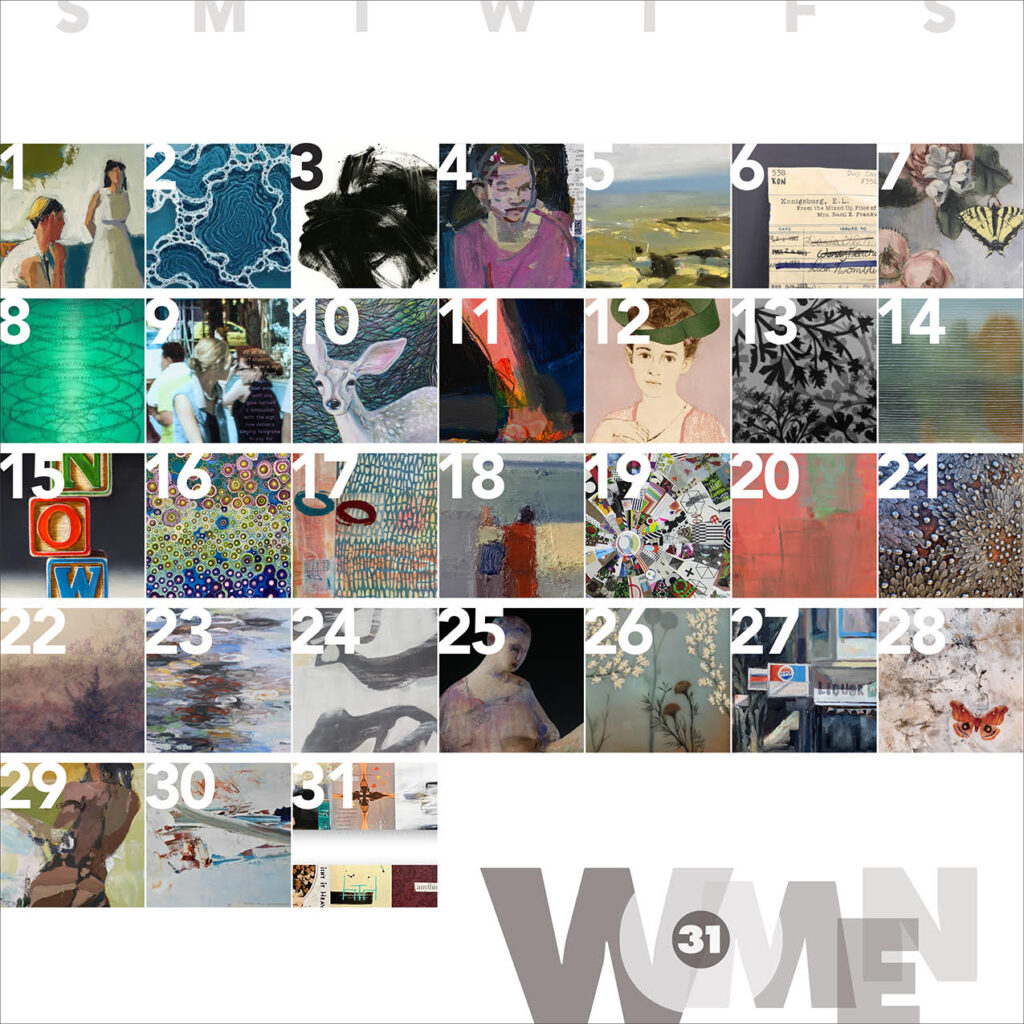
Whitney Modern is pleased to present 31 Women, an exhibition curated by Marianne McGrath with Karen Gutfreund and Suzanne Whitney-Smedt. 31 Women celebrates the work of 31 female artists in honor of Women’s History Month 2020. Women’s History Month annually commemorates women’s contributions to history, culture, and society throughout the United States. 2020 is an especially exciting and powerful year for women as it is also the 100th anniversary of the 19th Amendment, which granted women the right to vote in the United States.
Highlighted individually throughout the exhibition are each artist’s process and inspiration, as well as her sense of connection to women in history and art history, distilled from dozens of interviews, correspondence and conversations. Along with the physical exhibition at Whitney Modern, the artists from 31 Women will be featured daily on social media, blogs, websites and in the gallery–one woman a day throughout the month of March. This aspect of the show is intended to be a virtual exhibition available to those outside the area and provides an individual focus on a particular artist, emphasizing her unique practice and contributions to the art community.
31 Women affirms that knowing one another empowers us. Connections past and present celebrate, support and strengthen the collective creativity of all women. Sharing our stories of women that influence us honors our past, while showcasing the work of women today crystallizes our appreciation of the present. Through such shared perspectives, we can inspire future generations of women.
Day 1: Linda Christensen, http://www.lindachristensen.net
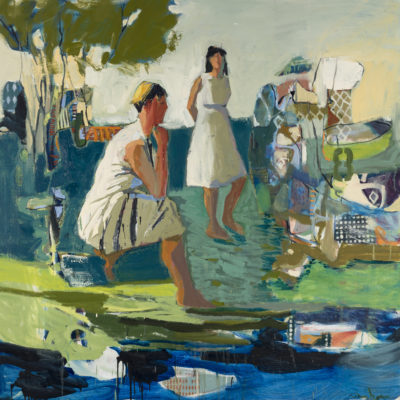
As a California Bay Area native, Linda Christensen has always drawn inspiration and serenity from her natural surrounds, especially the coast. In her evocative paintings of ocean landscapes and domestic interiors, Christensen pays homage to the universality of human emotion. More than merely observing the figure, the viewer is invited to sympathize with the subject. Christensen states: “It is not enough to simply observe; we understand ourselves and others through feeling, through checking in emotionally. As a child I was always in tune with the subtle shifts in mood of those around me and this sensitive observation of strangers has continued to inspire my work as an artist.”
When reflecting upon the work of other women artists, Christensen recalls writing about Gabriele Münter in college and being impressed by her use of both line and color, as well as her perseverance as a woman artist more than a century ago. Münter was married to artist husband, Wassily Kandinsky and found it difficult to be recognized in her own right as a painter. She admires Squeak Carnwath for her deeply personal work that, like Christensen, has connections to childhood. She is also inspired by Joan Mitchell’s abstraction and Dorothea Lang’s ability to capture the emotions of the time through photography.
Linda Christensen is represented by Gail Severn Gallery, Sue Greenwood Fine Art, Winfield Gallery and Stremmel Gallery. Her work is prized in numerous public and private collections across the United States.
Day 2: Carla Goldberg, http://www.carlagoldberg.com
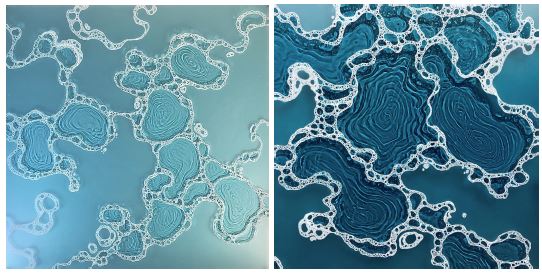
resin on acrylic panels, 36 x 36 inches each, (diptych)
Carla Goldberg always knew she would be an artist and blames it on a Bugs Bunny episode where Bugs is running away from a big red furry monster and then blends into the background dressed as a French artist. She remembers wanting to be an artist from that moment on and begging her grandmother for paints, canvas, a French beret, smock, and art classes. Her grandmother took her to the only art class she could find: an adult painting class two bus transfers away at the Palm Springs WMCA. Goldberg says, “she convinced them to let me in at 4—I behaved when I had a paintbrush in hand.” Goldberg later studied art at University of Redlands, Johnston Center for Integrative Studies and graduated with Honors. For her, it was the beginning of a lifetime of chasing ideas and experimenting. She went on to earn her MFA from MICA Mount Royal School of Art where experimentation was emphasized.
Today, rather than Bugs Bunny, women artists like Yayoi Kusama and her polka dot infinity work inspire Carla Goldberg. Likewise, Goldberg’s own seafoam drawings are comprised of hundreds of thousands of micro polka dots. She appreciates Helen Frankenthaler for her innovative stain paintings process, since Goldberg also uses a lot of stains and pooling of paint. She feels a connection to Agnes Martin’s minimalist paintings, which to Goldberg are tiny lines of humanity. She sees pattern, texture and light in Martin’s work and finds this similarly in her own work.
Carla Goldberg tends to be most influenced by the artists around her currently making art. It’s the comradery and community that has grown between herself and fellow artists (mostly women) that nourish her practice, from conversations or sharing information, to discoveries and just bouncing off ideas. Goldberg says “It’s important to have community and a sense of camaraderie.”
Day 3: Rozanne Hermelyn, http://www.wordpress.hermelyn.com
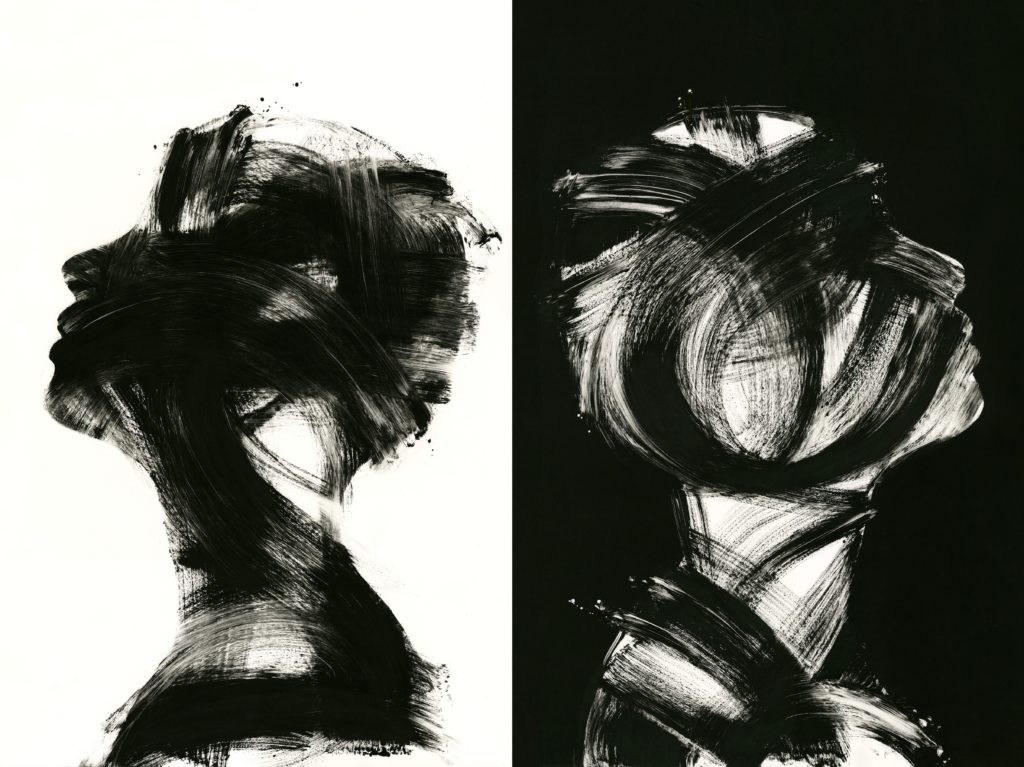
Rozanne Hermelyn is a San Francisco Bay Area artist working in printmaking and mixed media. Since she can remember, she has painted, drawn and followed her passion for the arts. Hermelyn tells us “I’ve been creative every day most of my life. It’s like breathing—not a want, but a need.”
Growing up in Los Angeles, Hermelyn attended UCLA and Art Center College of Design, receiving a BA in design and BFA in graphic and package design with distinction. She moved to San Francisco to begin her career and within five years became owner of Arc & Line Communications. Her mother’s death was a pivotal experience, marking the first time she entered a series of monoprint paintings into a juried show—winning the Best of Show award for the exhibition. The images portrayed moments of illness and suffering that come with terminal cancer; they were her tribute and final goodbye to her mother.
When asked about the women outside of her family that have inspired her, Hermelyn cites Idelle Weber, an American pop artist and later photorealist, known for her figurative silhouette paintings, photorealist trash and litter works; she appreciates how Weber reinvented herself and her work from one extreme to another. Hermelyn notes that she loves anything with type and finds inspiration in the work of Corita Kent, a mid-century LA pop art screen print artist that “juxtaposed ads, street signs, billboards with poetry, scripture and song lyrics, transforming them to hopeful messages and call for action.”
After twenty years in her successful design business, Hermelyn has now transitioned to focus full-time on fine art. She has been awarded Best of Show and 1st place in numerous exhibitions, her work is shown nationally and abroad, and can be found in the permanent collections of the Harvard Art Museums and the Library of Congress.
Day 4: Jennifer Pochinski, http://www.jenniferpochinski.com
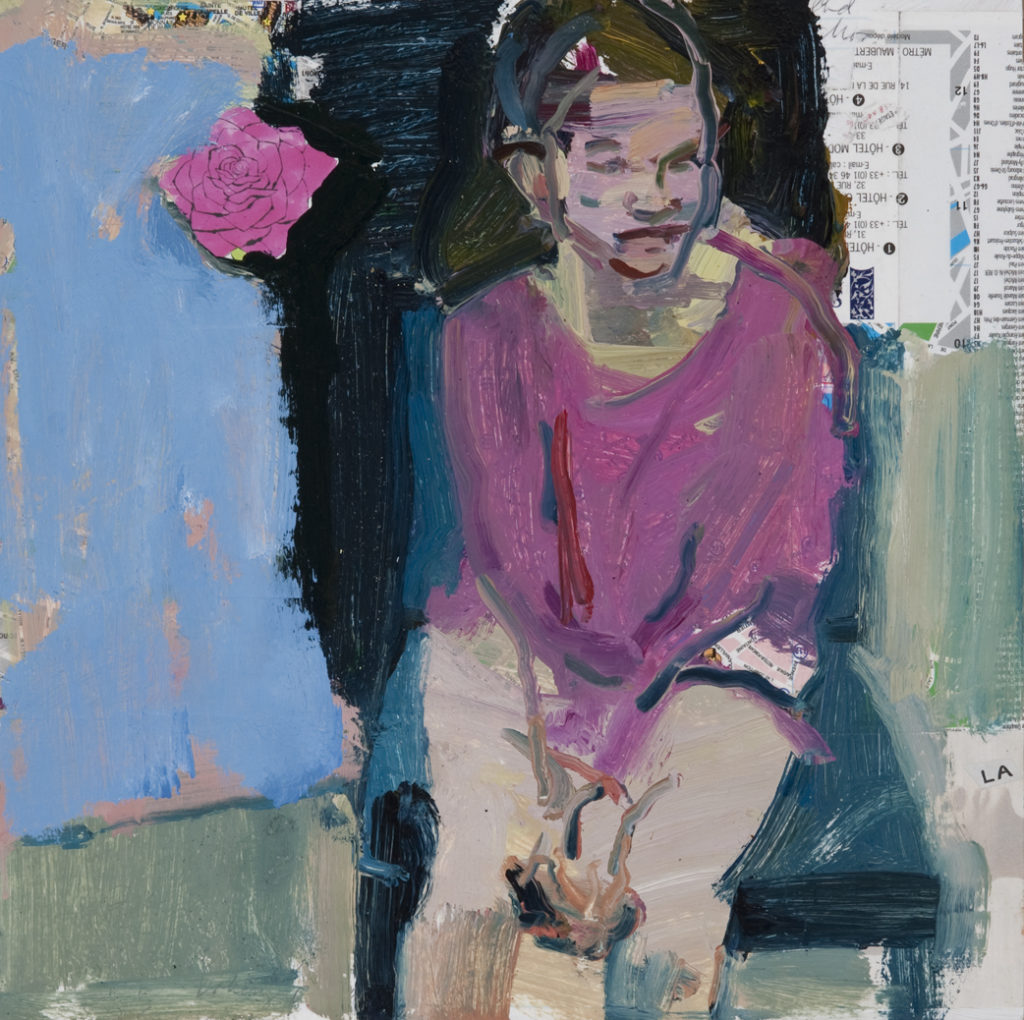
Jennifer Pochinski is a Northern California based figurative artist. Raised in Hawaii, she earned a BFA from the University of Hawaii and spent much of her young adulthood traveling to the UK and Europe, finally settling near Athens, Greece in 2003. In late 2010, she and her two children relocated to California.
She tells us “My studio practice is considered a ‘space to fail’. I have no specific method for painting. As with most ‘expressive’ painting it is never a linear process.”
For years now Pochinski has collected photographic imagery—figures, environments and historical paintings that give her information that she cannot get in life, striving for paintings that were very much of the moment. Now she feels more like an author, each day writing something that feels true to her, at the end putting it together to make a story.
The stories of other women artists inspire Pochinski. While reading Ninth Street Women, she was reminded of her love for the work of Lee Krasner, which in person always “stops her in her tracks.” In particular she recalls a story about Krasner being so fed up with her work, she ripped up the canvases and shed them on the floor. A few days later Krasner came back to her studio and found them together looking like collages and it set her on a new, powerful path. In dealing with the emotion that comes when something doesn’t work, it heartens Pochinski to be reminded that “some good can happen when you get to the brink!”
Jennifer Pochinski is represented by Dolby Chadwick, San Francisco; b. sakata garo, Sacramento; Tregony Gallery, UK; and Baker Schorr Fine Art, Midland, Texas.
Day 5: Julia Jensen, http://www.juliajensenstudio.com
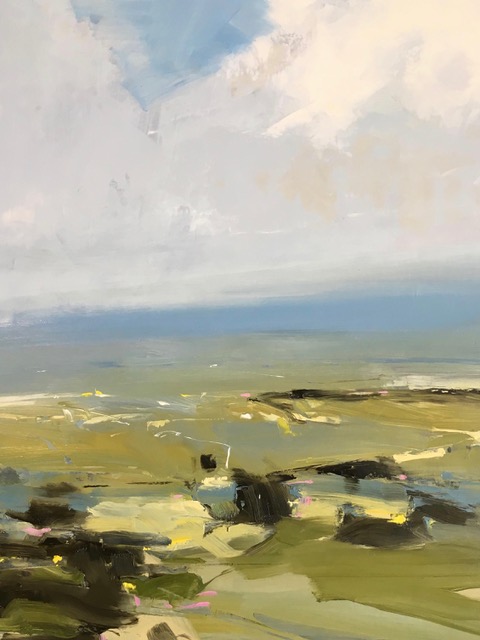
When Vermont landscape painter Julia Jensen was asked about the women from art history that have made an impact on her practice, she revealed her interest in Hilma af Kilmt and a number of previously overlooked early 20th century women artists like Emma Kunz and Georgina Houghton. Jensen discovered that these artists saw their art as messages from an unseen source. They were dismissed by their peers, but what they were bringing forth was completely original responses to internal worlds. It made sense to Jensen that women were the source for this kind of work and that it would happen outside of any kind of movement or officially sanctioned group. She feels that because these artists were ignored, “they were completely free to follow their instinct and able to be honest.”
Similarly, Julia Jensen finds that a deep connection to herself, and perhaps even something beyond herself, is what she is trying to explore in her art. However, she doesn’t intend it to be a solitary exercise, she aims to connect with others through her painting. With this in mind, Jensen continues to include references to the external world to give others a path into her work. Using landscape as jumping off point also gives her a handrail into the process. She states “I have tried to paint completely non-objectively and just find that I am at a loss, the process becomes arbitrary. I need to have some kind of structure, and for the time being landscape is what is serving me.”
Julia Jensen is represented by West Branch Gallery, Stowe, VT; Northern Daughters, Vergennes, VT; DaVallia, Chester, VT; Whitney Modern, Los Gatos, CA and Water Street Gallery, Douglas, MI.
Day 6: Jeanne Vadeboncoeur, http://www.jeannevadeboncoeur.blogspot.com
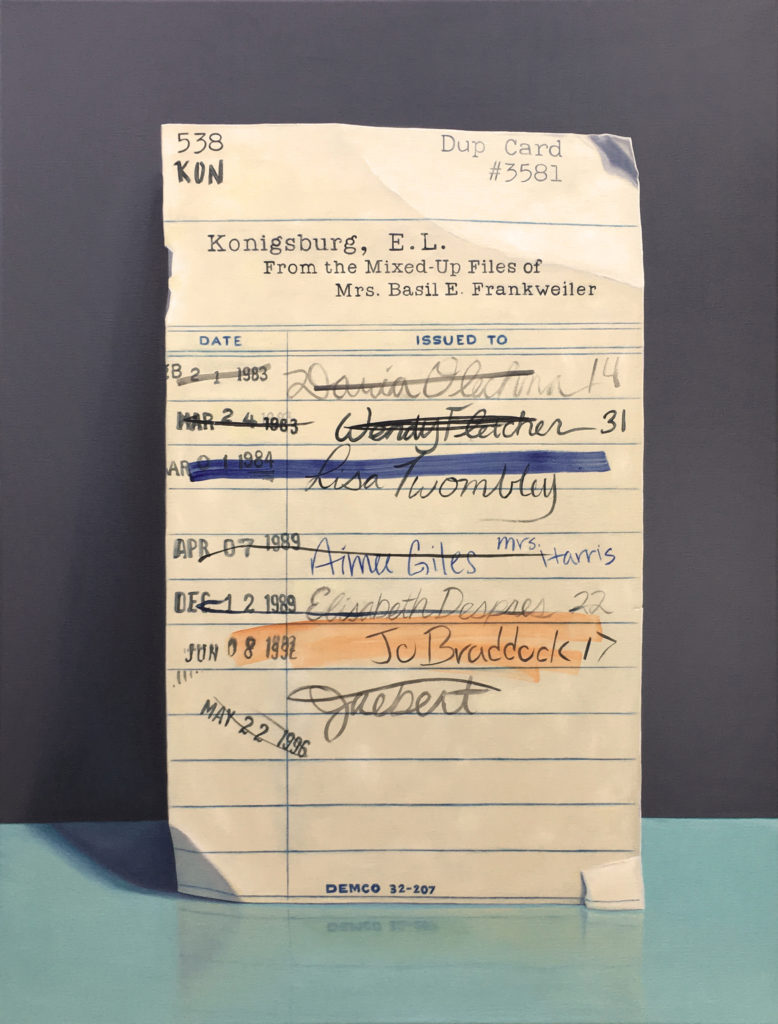
Bay Area artist Jeanne Vadeboncoeur studied art at Laguna College of Art and Design and earned her BFA from San Jose State University. She says “I’ve always been creative but have a strong analytical side too. I think that’s why my work is so literal and precise.” She thought that she had found the perfect blend of art and science in the field of art restoration and was heading that direction when an opportunity came her way to take a more traditional studio arts path. Vadeboncoeur’s still life paintings, usually rendered in oil with exact precision, explore commonplace objects that we often overlook in our daily lives, such as: gummy bears, a paper airplane or a library card. Her paintings invite the viewer to find joy in life’s simple pleasures.
In contemplating her sense of connection to a particular woman artist from history, Wendy Pini comes to mind. Pini is the artist and co-creator of an independent comic called “Elf-Quest.” Vadeboncoeur credits Pini for single handedly launching her from a child who liked art to self-actualized artist. Many of her other female role models have been familial or literary. In particular she recalls the strength and endurance of her librarian paternal grandmother who went back to school for a masters while raising ten children. Literary role models were found in the “sheroes” created by Tamora Piece, Joan Aiken, Mercedes Lackey, and Anne McCaffrey. The characters she connected most to were tough, independent, problem-solving girls and women.
Vadeboncoeur has shown at the San Jose Institute of Contemporary Art; the Herbert Sanders Gallery at San Jose State University; the San Jose Museum of Art; Triton Museum of Art, Santa Clara; Bryant Street Gallery, Palo Alto; Visual Aid, San Francisco; and Gold Gallery, Boston.
Day 7: Stephanie Peek, http://www.stephaniepeek.com
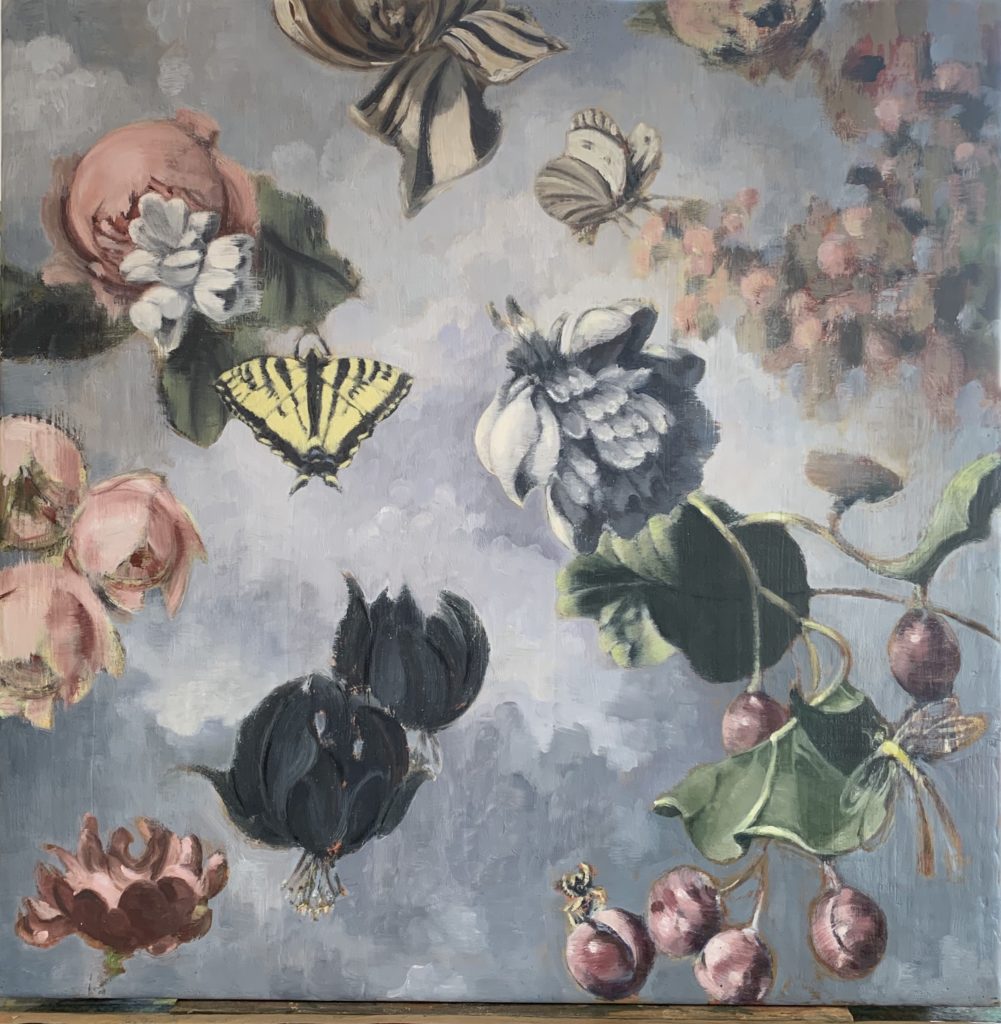
The genesis of much of Stephanie Peek’s painting comes from the garden of La Pietra in Florence. La Pietra elicited memories of a garden that Peek had known as a child. Revisiting these sites from memory in her studio, she became aware that paintings themselves could be a refuge, as gardens are in real life; they could be a site of meditation. This romantic notion inspired her Dark Arcadia series exhibited at the Berkeley Art Museum and was furthered during her stay as a visiting artist at the American Academy in Rome, where she studied more Renaissance gardens.
Into one of these dark paintings, Peek painted a loose rendering of a deep red flower from a still life by 17th century painter Rachel Ruysch. Not only admired for her perseverance and success as a woman artist in the 17th century, Ruysch worked from age 15 to age 83, while at the same time raising her 10 children. Peek is drawn to Ruysch’s free and luscious floral work, rendered in rich colors that glow out from dark backgrounds.
In addition to floral borrowings from the Northern European tradition, Peek appropriates flowers, leaves, insects from many different sources; for example, the iconic magnolia from the 19th century American painter Martin Johnson Heade. She also works from direct observation and photography. Peek finds inspiration in the writings of Agnes Martin and Barbara Hepworth for the spiritual dimension brought to their practice. Most of all, Peek’s painter friends have been inspiring by being both encouraging and critical.
Stephanie Peek is represented by Seager Gray Gallery, Mill Valley, CA ; Satellite of.Love, San Francisco, CA; SFMOMA Artists Gallery, San Francisco, CA; Michelle Bello Fine Art Consulting; Sloan Miyasato, San Francisco, CA; Andra Norris Gallery, Burlingame, CA; Argazzi Art, Lakeville, CT; Jason McCoy Gallery, New York, NY; The Great Highway Gallery, San Francisco, CA.
Day 8: Michelle Mansour, http://www.michellemansour.com
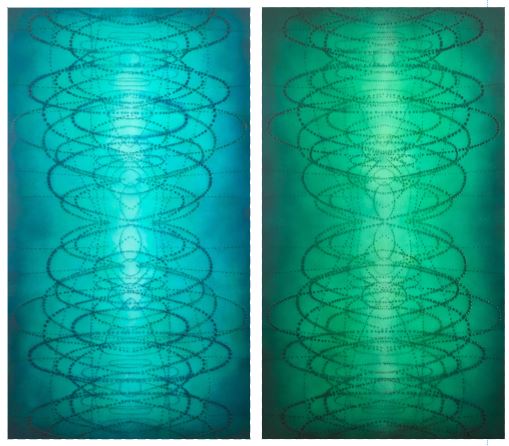
Michelle Mansour is an artist, educator, curator, and the current Executive Director of Root Division, a visual arts non-profit in San Francisco. Her work as been shown in a variety of non-profit and commercial venues and can be found in both public and private collections. Mansour’s work is a convergence of art, science and spirit. She says that her paintings are based “on an investigation of the interior world of the body where beauty and illness mingle in the same fluids and membranes…[and] become a broader reflection of where science and the metaphysical intersect.” Her work invites the viewer to slow down and contemplate their own mind, body and spirit.
Mansour’s process includes the application of fluid pigment to wet surfaces, the marked ground referencing a stained biology slide. She then applies tiny marks and patterns to create an ethereal space where particles gather and disperse in an endless geometric cycle. The repetitive process of adding layers of material to the bead-like patterns create an interconnected relief of rhythmic texture, ordered like data points but rendered in gemstone colors that are reminiscent of chakras or healing crystals.
Traversing between organic fluidity and structured symmetry, Mansour uses this combination of techniques to ask us to reflect on “what we can and cannot control, as well as the exquisite and delicate balance between certainty and faith, what is known and unknown, and holding on and letting go.”
Mansour’s themes come from growing up in a family of science and health practitioners; her mother was a nurse and her father was a doctor. Her focus on this subject matter intensified when her mother was diagnosed with, and ultimately lost to cancer. The process of repeating layer upon layer, mark upon mark, becomes a devotional practice, much like prayer beads or a meditation to contemplate the relationship between spirit and matter, presence and loss.
Day 9: Sherry Karver, http://www.sherrykarver.com
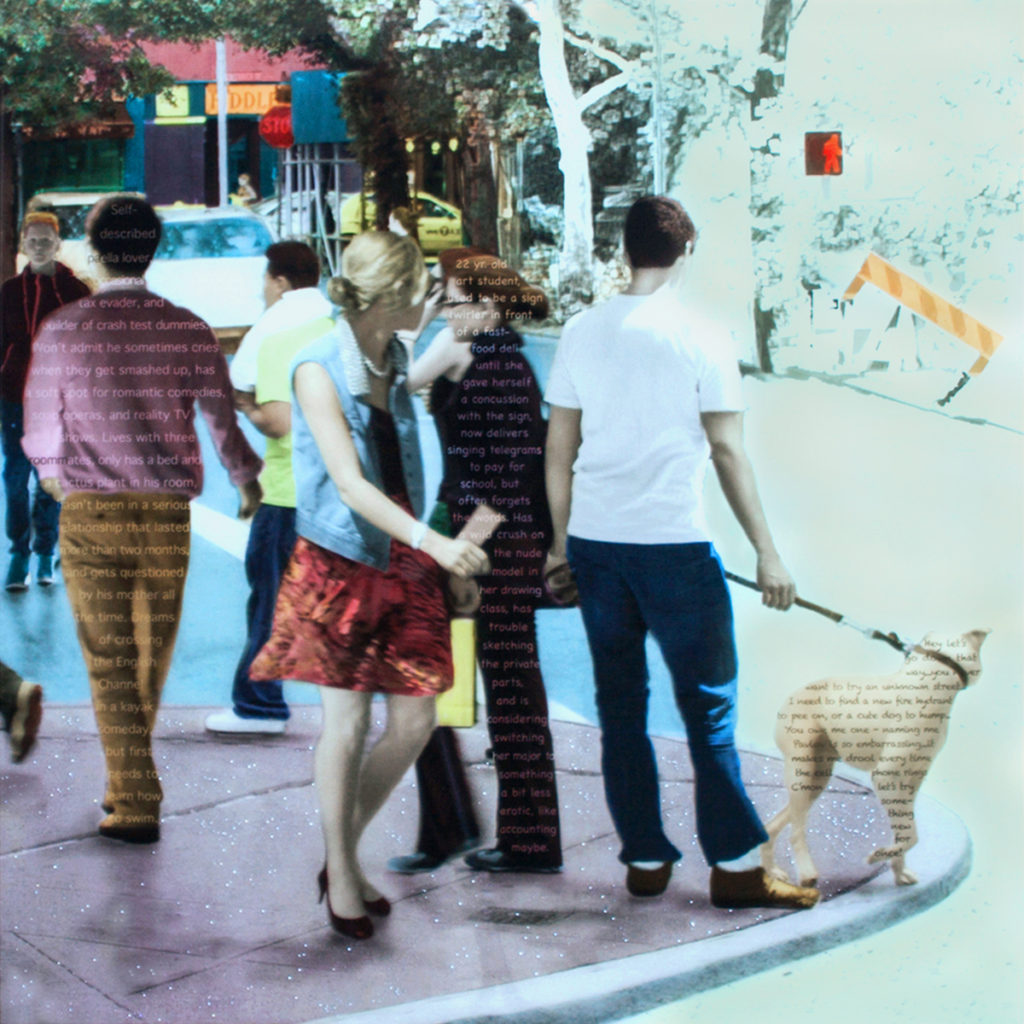
As an only child Sherry Karver found ways to be creative at a very early age, collecting rocks and shells to build little sculptures on the kitchen table. She attended children’s painting classes on Saturdays at the Art Institute of Chicago. Although she always loved art, she didn’t seriously pursue it in college earning her undergrad degree in Sociology from Indiana University. She took one or two art classes each semester and during her senior year, took a class in ceramics and was hooked! Clay spoke to her like nothing else ever did. After graduation she went back to the Art Institute of Chicago and to Loyola University part-time and took more ceramic classes to hone skills. She recalls that she “met the amazing ceramic artist Ruth Duckworth, who really became my main inspiration even though I never had the opportunity to study with her. To this day I love her work.”
Karver continued this path in graduate school at the Newcomb School of Art of Tulane University, receiving her MFA in ceramics, and going on to teach ceramics at colleges and universities around the country, including Laney College in Oakland. Although she taught ceramics until just last year, her own work gradually shifted around 1996. Karver’s practice evolved into photography and painting, adding narrative text around 2000. Most recently she has been developing a new photography series that is printed as dye sublimation on metal.
Karver’s photo-based work in 31 Women combines photo images, with oil paint, narrative text, and resin surface on wood panel. This series, called Identity and Perception, confronts today’s individual and societal issues so rampant in our impersonal metropolitan areas: alienation, loneliness, loss of identity, time passage, and how others view us. Karver writes fictional bios on some of the figures as a way to personalize them and make them stand out from the crowd since we each have a unique story to tell.
Sherry Karver’s work is held in more than 175 public and private collections and exhibited nationally. She has is represented by Stremmel Gallery, Reno, NV; Patricia Rovzar Gallery, Seattle, WA; Shayne Gallery, Montreal, Quebec, Canada and Cumberland Gallery Advisory, Nashville, TN.
Day 10: Marie Cameron, http://www.mariecameronstudio.com
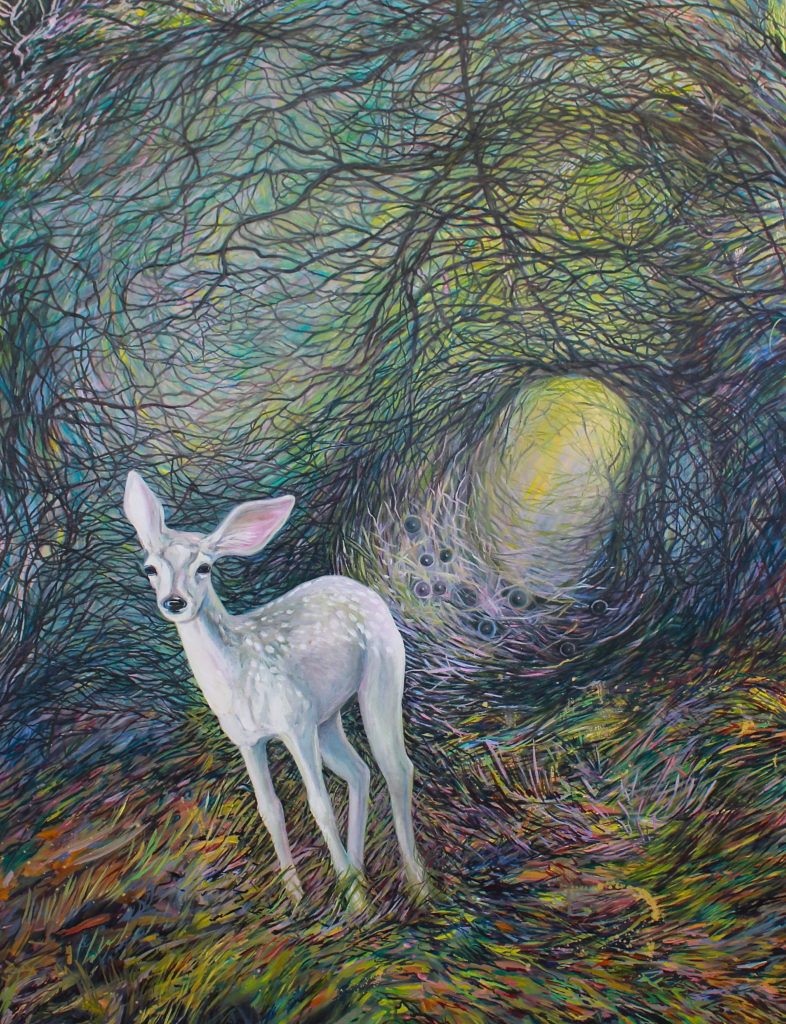
One of Marie Cameron’s favorite things is to have a long stretch of undisturbed time to work in her studio. Ideally, she starts full of possibility with a new canvas, reference material, creamy paint squeezed out on her palette, and clean brushes on hand. Cameron says she is at her best in the morning, so she protects that quality painting time, taking breaks in her garden to stretch her body and eyes, get some clean air and to see what’s blooming. To help keep things fresh she likes to rotate through her various series, working on something very large, followed by something very tiny, working with something very familiar, then playing with unfamiliar materials. Cameron primarily works in oil; however, mixed media assemblage and encaustic are part of her practice. Threading through her work are themes that reflect the fleeting nature of life. She brings this perspective to her environmental work and human nature pieces.
Cameron had a creative childhood, inspired by and close to nature; and nature is still one of Cameron’s primary inspirations. She loves to spend time by the sea, hiking in the woods, and in her own garden, which attracts many birds and deer, reptiles and insects. Antiquing is another inspirational pursuit, as she ponders what objects can say about who we are or were. Gallery and museum going is also endlessly inspirational to her in learning how other artists approach their work, as well as in feeling connected with the art community.
When asked about inspirational women, Frida Kahlo was at the top of Cameron’s list that included Maria Sibylla Merian, Ayesha Durrani, Malala Yousafzai, Michele Pred, Elizabeth Kolbert, Rachel Carson and Rachel Maddow, Greta Thunberg, Toni Morrison, Ruth Bader Ginsburg, Danielle Krysa, Rina Banerjee, Pantea Karimi, Ana Theresa Fernández and Maude Lewis. Cameron draws much from Kahlo as a person, as an artist and a feminist, explaining that she loves “the way Kahlo was able to tell her personal narrative through her art in a way that was grounded in her cultural tradition but also universally accessible…she painted through pain and love, living her life as art.”
Day 11: Lisa Noonis, http://www.noonisfineart.com
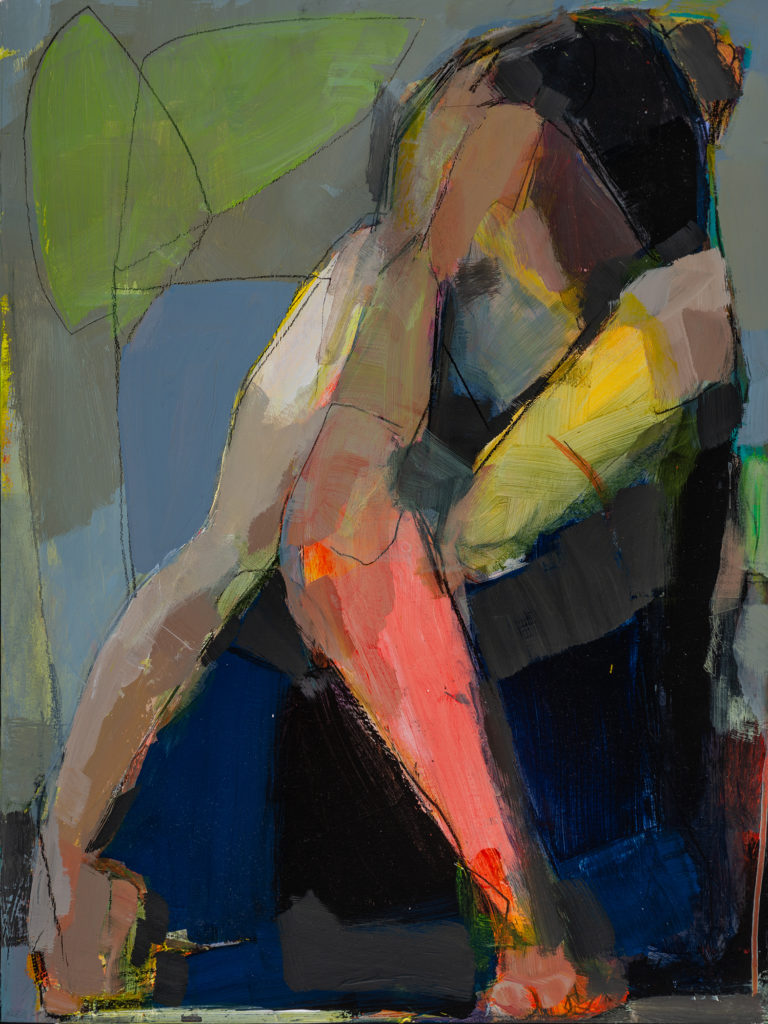
latex mounted to panel, 28 x 18 inches, float framed
Lisa Noonis grew up in a large, loving Greek family and is still inspired by the memory of her Yia-yia (grandmother) who was patient and present, teaching her that life was like sorting rice—you have to pick out the bad and keep the good. Noonis discovered art early in life, winning first place in a children’s art festival and showing so much talent that her high school art teacher insisted that she go on to art school and pursue a career in the fine arts. After a detour as an engineering student her first year of college, she went on to earn her BA in art, communications and advertising.
Noonis worked at a communications firm, then embarked on her own as a freelance graphic designer and art director, eventually forming her own successful advertising, marketing and design company. But something was missing and she always felt the need to express something more personal and more permanent than ads, logos and brochures. She finally made a leap of faith by renting a studio and committing to seriously pursue fine art. Noonis took workshops, studied with masters and painted every day—still life, portraits, landscapes, and anything that would sit still in the studio or in front of her canvas.
Her early work and vision were visibly influenced by such masters as Cezanne, Modigliani and Morandi. However, she cites Joan Mitchell and Helen Frankenthaler as inspirations for their courage and for the sheer scale and energy in their work. Similarly, Noonis often works in large scale. A 9’ x 19’ span of paper may stay on the studio wall for months, allowing her the time, freedom and space for continuous thought. Once the concepts are complete, she cuts and crops into individual works to be mounted on panels.
Lisa Noonis’ creative practice has changed over the years from advertising to fine arts and from there, as realism evolved into abstraction, painting from life into painting from memory, small canvases into large. Today, she continues to evolve and grow as an artist as she explores the objects, people and places in her world.
Day 12: Ellen Heck, http://www.ellenheck.com
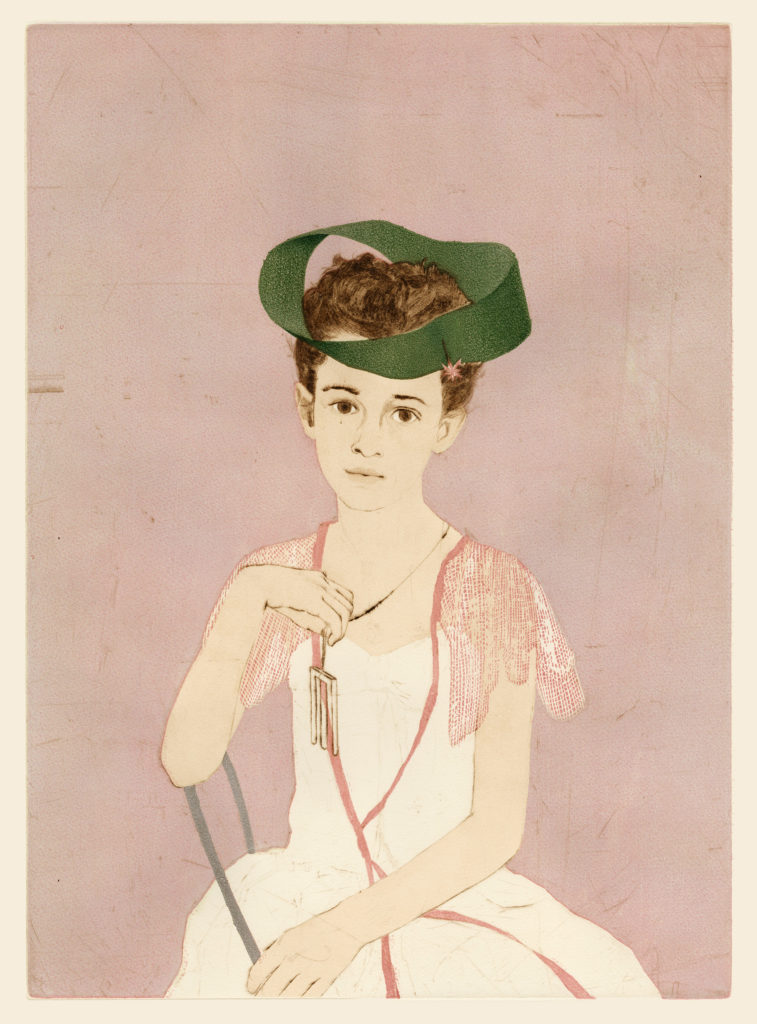
Ellen Heck works as a printmaker in North Carolina. Over the past decade she has explored specific questions about identity—its creation, variability, persistence and change by combining subject matter and thematically resonant printmaking techniques. Heck is interested in making work that shares a sense of wonder. She also uses a body of work as a way of exploring an abstract question or concept; mathematics and geometry are often part of this process. She finds shapes like the Möbius strip or Klein bottles appealing because of their open-ended possibilities and the poetic nature of their definitions. Generally, this practice of intellectual investigation gives rise to more questions, which become the foundation for the next series. Heck has been predominantly a printmaker, but more recently she has been working on a new series of paintings that study portraiture, symbolism, and topology inspired by William Adolphe Bouguereau’s Broken Pitcher.
Heck attended Brown and The School of the Art Institute of Chicago. However, her mother is a commercial artist and since her early days has been her most influential teacher. During art school and at the beginning of her professional life Heck was able to work freelance for her mother. This allowed Heck time to work at Kala Art Institute in Berkeley during the day and make more reliable money doing graphic design at night. Working at Kala for nearly seven years was the foundation and formation of her career, and while there she was part of a critique group of artists who became mentors and close friends.
Heck frequently discovers new ideas by reading and through teaching. She been deeply inspired by the work of Mary Cassatt, Dieter Roth and David Hockney. The set of 10 color prints are her favorite works by Cassatt and her favorite works of printmaking in art history. Heck’s first gallery solo show was based on this series. In addition to Mary Cassatt, artist and author Audrey Niffenegger, and author Maria Popova have influenced and inspired Heck.
Ellen Heck is represented by Wally Workman Gallery, Austin, TX; Davidson Galleries, Seattle, WA; Groveland Gallery, Minneapolis, MN; Kala Art Institute, Berkeley, CA and Baker Schorr Fine Art, Midland, TX.
Day 13: Laura Gurton, http://www.lauragurton.com
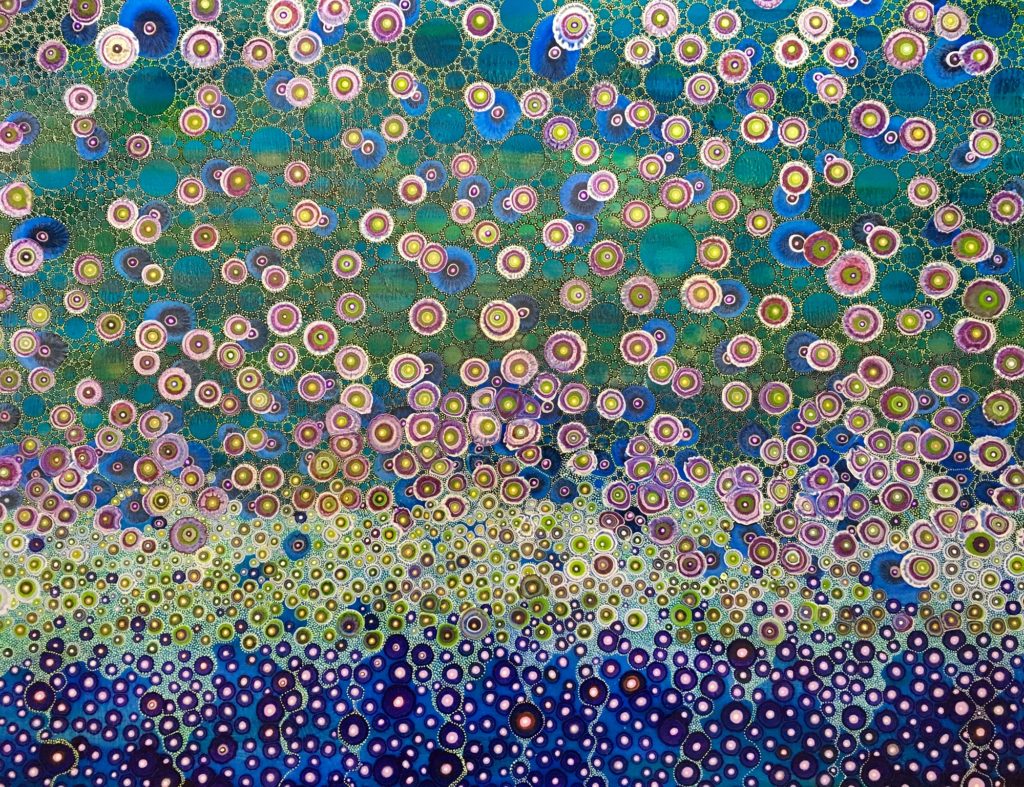
Unknown Species #215, 2017, oil, alkyd, ink on linen, 30 x 36 inches
Laura Gurton’s childhood was filled with museum visits, art books, the theater, ballet, foreign films, music, and art classes at the Brooklyn Museum. It is no wonder that she went on to study art in college; first at Philadelphia College of Art, and then The School of Visual Arts in NYC. She looks back with gratitude to her teachers: May Stevens was generous with her time and her experience; Marsha Tucker, who had just started the New Museum, taught a class about the art world; Audrey Flack and Alice Neel co-taught a painting studio. Having these women artists as teachers and role models made it seem quite possible that she could succeed as well. Gurton later returned to SVA to take art education courses to become a high school art teacher. A few years later she earned a Masters in Supervision and Administration in the Arts from a joint program run by Bank Street College of Education and Parsons School of Design.
Gurton’s paintings consist of concentric circular lines and colors that mimic pieces of agate, rings inside of trees, mold, other patterns in nature and most importantly, microscopic cells. She once read that when humans are born, they have an instinctual attraction to the shape of concentric circles, which makes sense since the nipple is the first shape they need for survival. She has always been fascinated with the idea that we have instincts towards shapes. Her paintings are titled the Unknown Species, a phrase that suggests that her shapes are alive. Gurton states that she sees “the shapes with their concentric circles as representing time itself, displaying their growth like the rings in a tree which come with age.”
When thinking of inspirational artists, Gurton recalls learning about Paula Modersohn-Becker in an art history class. She was intrigued by her abilities, the beauty of her paintings, and her life. She then found the book Paula Modersohn Becker: The Letters and Journals and learned more: that at times Modersohn-Becker left Germany, her husband, and her stepchildren to paint in Paris. The more she read, the more connected she felt to this incredibly brave German woman who died in 1907. As a woman coming of age in the 60s and 70s, Gurton says that was influenced by Gloria Steinem and Andrea Dworkin, among others. She was interested in the suffragettes and in women’s history, joined women’s support groups, and tried to raise her daughters “thinking about what they were up against.” Today she expresses appreciation for the Guerrilla Girls, women’s marches, and “my daughters, both very amazing and powerful women.”
Day 14: Pantea Karimi, http://www.panteakarimi.com
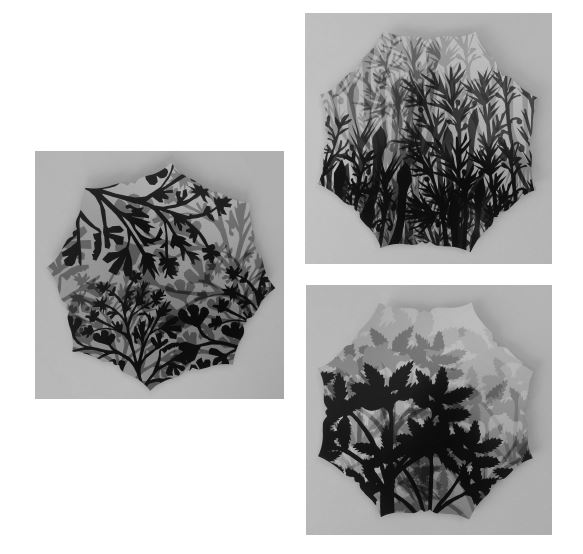
12 x 12 inches each, (triptych)
Pantea Karimi’s work as a multidisciplinary artist explores the intersection of art with history and science, and examines how the broader aesthetic considerations of science are closely related to art. She is captivated by the correlation between abstract ideas and their visual representations. Part of her practice involves research on illustrations and texts of medieval Persian, Arab and early modern European scientific manuscripts in five areas: mathematics, medicinal botany, anatomy, astronomy and cartography. For Karimi, these manuscripts provide a unique platform for investigating the influence of past scientific concepts and their manifestations on our contemporary perception of the world. They represent world cultures, their values and the progression of scientific ideas throughout history. Utilizing conceptual and visual interpretations from her research, Karimi creates individual bodies of artwork using interactive installations, VR, silkscreen, digital illustrations, and prints.
Immigrating was an inspiring experience and has strongly influenced her work. Karimi is a two-time immigrant from Iran to the UK and to the USA. On a personal level, immigration provided challenges in the beginning, but at the same time it presented great opportunities for her art practice and creative path. Traveling and living in diverse communities have informed her art content and identity as an Iranian-artist woman, broadening her world view.
Karimi grew up in Iran during turbulent times of revolution, war and family tragedy. Despite all the hardships, she managed to take regular classes in painting and classical music, which led to her decision to pursue art professionally. She earned her Bachelor’s and Master’s degrees in Graphic Design in Tehran. She later moved to England, where she had opportunities and creative time to explore new media and printmaking techniques. This experience became a foundation for her art practice, which she continued at San José State University, earning a second Master’s degree in painting and printmaking.
Karimi draws inspiration from artists from around the world, her peers, and from a variety of art genres. When it comes to female artists, she is usually inspired by their biographical narratives such as their struggles, achievements, and creative paths. She made a list of few women with the reasons why and how they inspire her as an artist: Artemisia Gentileschi, her female perspective, highlighted in all of her paintings; Louise Bourgeois, her thought process and artistry; Louise Nevelson, her use of materials and composition; Barbara Kruger, her use of bold images and texts, the message of her works; Sally Mann, her work and creative process in general; Marlene Dumas, for how she draws inspiration for her works’ imagery and content from published media, such as newspapers and magazines. Her female figurative paintings have elevated the subject from its roots in vanity, using it to depict personal, psychological, social, and political concerns; Es Devlin, her most amazing, creative theater and stage-sculptures, for her confident thought process and outcome; Marina Abramović, her persistence, the power of performance and feminist art; and Monir Shahroudy Farmanfarmaian, for the beautiful use of her Iranian heritage techniques and materials: mirror-mosaics. Her work is a perfect marriage between Iranian and the Western culture while keeping her Iranian identity dominant.
Day 15, Astrid Preston, http://www.astridpreston.com
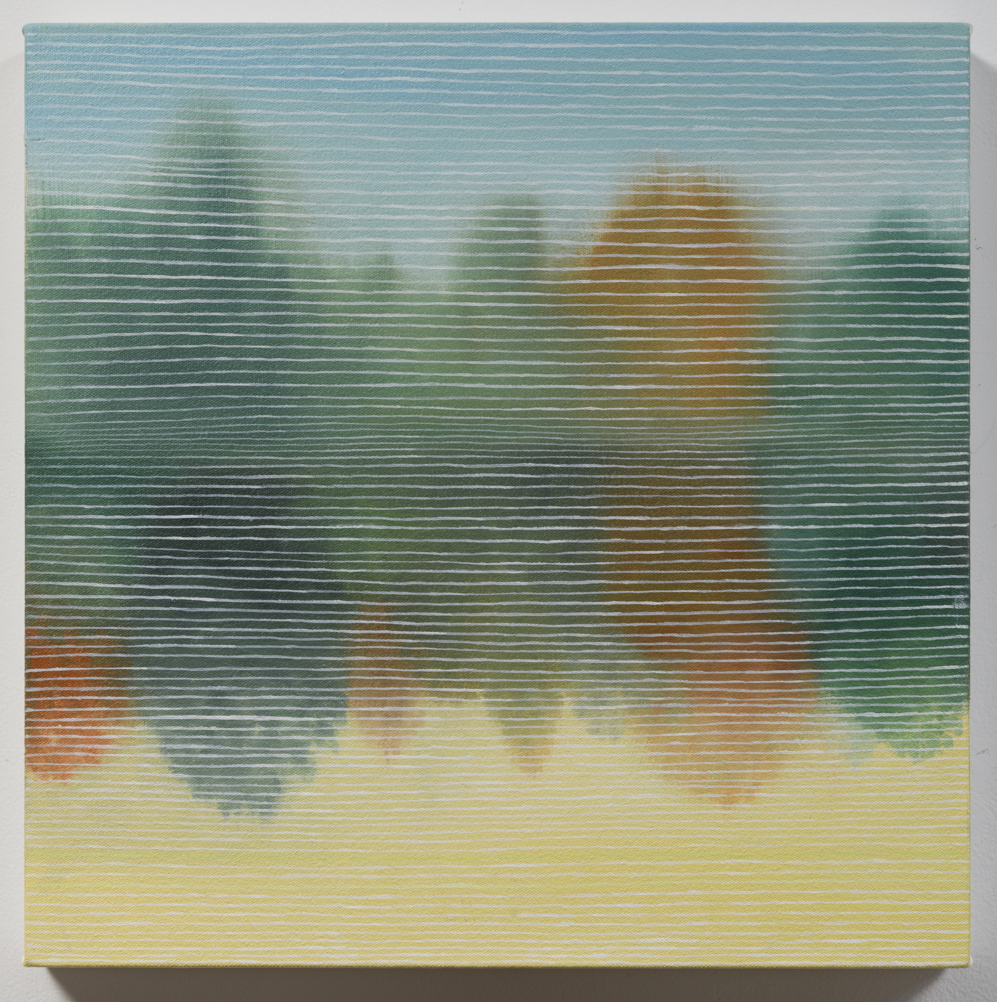
Astrid Preston is a Los Angeles based artist. Her mother and father were both architects who met at the University of Riga, Latvia. In 1944 with the Germans retreating and the Russians advancing on Latvia, her parents, separately, escaped to Sweden and reunited in Stockholm; she was born nine months later. Preston was a physically active child and liked to stay busy. Fortunately, there was loads of paper—old blueprints made for great drawing supplies. By the time she was a teen, Preston started taking classes in figure drawing, which she continued for many years.
After graduating UCLA as an English major, Preston realized that art was the pursuit that she found most challenging and enjoyable. Working mainly with oil on canvas, her themes have focused on nature since about 1978. Ideas come out of “the working” shifting from realism toward abstraction and the play between the two. Her paintings also shift in scale, from very small works of landscape or birds, to very large paintings that take between six months and year to paint.
Preston says that having a child, and later visiting Japan affected her work strongly. Her love for Renaissance painting has influenced her technique. When considering her inspiration, there are tangible things like a sunset, a tree, a forest, or a color. She also finds inspiration in seeing great art and is interested in what makes certain works surprising and of the moment. Louise Bourgeois still surprises her and elicits strong emotion. The paintings of Hilma af Klint and Agnes Pelton have been more recent pleasures. Preston loves the paintings of Joan Mitchel and appreciates Vija Celmins, as a brilliant Latvian artist, but there are many important women artists in her life, especially close friends like Lita Albuquerque and Karen Carson.
Astrid Preston’s work has been exhibited in galleries and museums throughout the United States and Asia. She has had articles and reviews of her work published in the Los Angeles Times, Art in America and ArtForum. Preston received an NEA Fellowship Grant in Painting in 1987 and an artist residency from Lux Art Institute in 2008. Her work is held in many public and private collections, including the Orange County Museum of Art, Long Beach Museum of Art, UCLA Hammer Museum, McNay Art Museum, Oakland Museum and Nevada Museum of Art. She is represented by Craig Krull Gallery in Santa Monica.
Day 16: Elizabeth Barlow, http://www.elizabethbarlowart.com
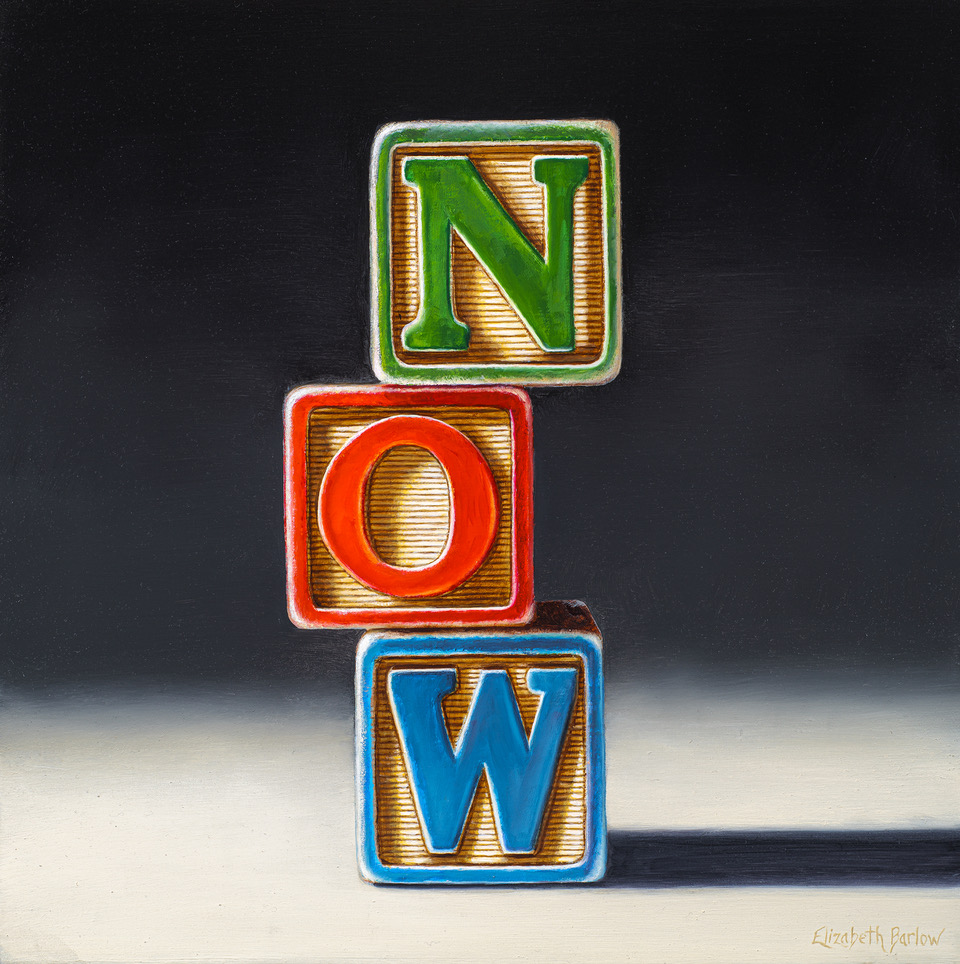
Elizabeth Barlow was always absolutely certain she would live a life creating “something”. Indeed, she is living a creative life—drawing as a child, visiting art galleries with her parents, a home with walls filled with her father’s paintings (Phillip Barlow, 1932-2018), as well as the work of many other artists. After undergraduate work in theater, journalism and history, Barlow studied painting at UC Berkeley earning a Post-Baccalaureate Certificate in Studio Arts and spent a semester at the Art Students League in New York City. At the present time, Barlow continues to create work for her series called Portraits in Absentia. In this series, she paints still life “portraits” of people using cherished or symbolic objects, rather than their faces, to illuminate their characters and lives. She is also working on a series called Portraits of Gardens in which she gathers flowers and branches from a particular garden and then creates a deconstructed still life that celebrates the character of that particular garden or gardener.
Barlow tells us that she has always been very disciplined. “Since I am a realist, there is the stark fact that my artmaking requires a lot of time.” Her days revolve around a very devoted studio practice. She believes that being a painter is like being a ballet dancer or a pianist, requiring a daily devotion to the practice. She recalls that “the great cellist, Pablo Casals was asked why, at 90, he continued to practice every day. He replied, ‘Because I see some improvement.’”
Inspired by other creatives, Barlow looks to Georgia O’Keeffe, Vanessa Bell, Anne Truitt, Mary Oliver, Suzanne Farrell and Rachel Ruysch, and essentially all of the arts: music, dance, theater, painting, poetry. “All that speaks of the hidden, mysterious inner essence residing in each of us.” Barlow continues to seek to find a way to express this hidden inner aliveness. Whenever she needs an energy boost, she turns to her books about ballet. “The great American ballerina Maria Tallchief told her students ‘Ballet is like a religion.’ What she meant is that it requires a religious devotion—to show up at the barre every day, no matter how much your body hurts and no matter what else is going on in your life. Just reading those words gives me energy and reminds me that my first duty is to show up at the easel—because it is in that showing up that the muses reside.”
Day 17: Jennifer Cole, http://www.jennifercoledesigns.com
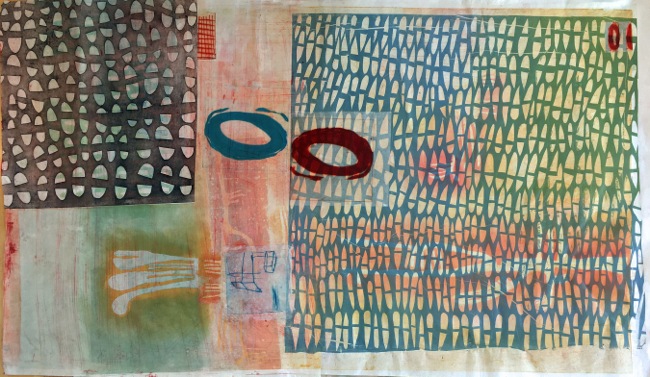
Growing up, Jennifer Cole had her own room—being the only girl in a four-sibling household had its benefits. Perhaps this was also an advantage for her in the spirit of A Room of One’s Own, because it afforded her a place and the freedom to make art and experiment without interruption. Her parents encouraged her natural creative proclivities and put an old door on sawhorses in her room to use as a worktable. Looking back, she realizes “what a wonderful and supportive situation that was!”
Cole pursued art because it was what she found enjoyable. In college she studied art at several schools, discovering printmaking along the way. After graduate school, she felt lucky to meet Kay Bradner, the owner of Katherine Lincoln Press. Cole says working for Kay was “where my real knowledge of printmaking took off. I learned to print all kinds of prints, wipe all kinds of ways, and appreciate printmaking in an entirely new way…I believe Kay was the best teacher and I still call her occasionally for help.” Cole also looks at the work of other artists and is inspired by many kinds of imagery, including those by Paul Klee, Kiki Smith, Kazuko Watanabi, Sean Caulfield and Golbanou Moghaddas, to name a few. Above all she is passionate about the process of printmaking.
Cole explains that “it’s hard to verbalize, but the joy that comes when working on printmaking is such a lovely and opening experience; that experience becomes the image. It means I go to work and really just enjoy whatever problem presents itself during the making of a plate.” Physical labor is definitely part of her process – scraping, burnishing, re-etching, re-aquatinting. For monotypes this means many layers and covering up parts of images that don’t work and tearing images down. Cole works with very little premeditated imagery, so her prints evolve and transform a great deal over time.
Daily routines for Cole include working at Kala Art Institute three days a week, other days she works at home. But mornings are always devoted to a meditation practice and walking the dog or/and yoga, which prepares her for printmaking in deeper ways. She feels this internal kind of work is most definitely expressed in some way through her art and that the understanding of what she learns through meditation and internal self-exploration is expressed visually.
Day 18: Sandy Ostrau, http://www.sandyostrau.com
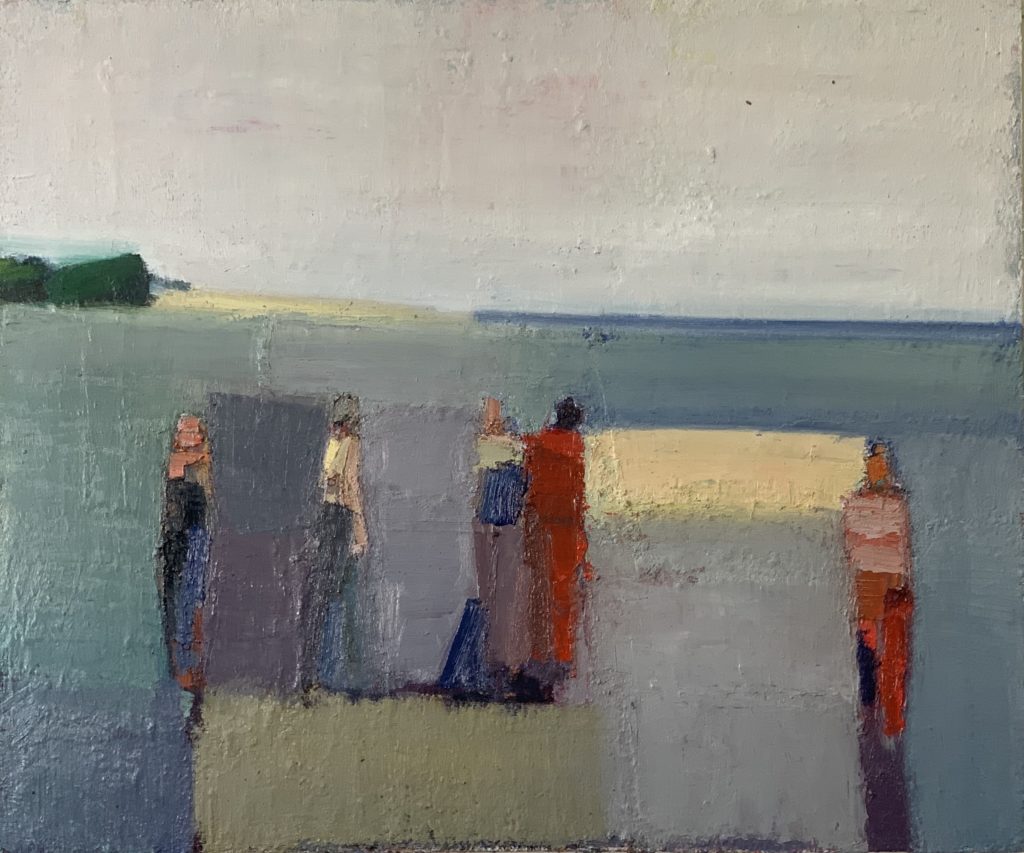
On a typical day, Sandy Ostrau arrives at her studio by 10am and begins by mixing colors. She finds the rhythmic movement of using the palette knife to mix a great warm up. Ostrau says “It’s a wonderful ritual to focus my attention and loosen me up. Most importantly it switches my thinking to a work mode.” Ostrau’s routine hasn’t changed much over the years other than she used to spend more time painting outdoors. She works with oil paint, but often sketches with graphite or ink, and sometimes paints with acrylic on paper for studies.
Ostrau grew up in Palo Alto and enjoyed art making from a very young age. “You could often find me surrounded by my treasured art supplies, drawing and coloring for hours at a time.” She studied Art History and took drawing classes at UCSB, along with numerous drawing and painting classes at the Pacific Art League and Palo Alto Art Center. After college she started a business selling her designs on textiles and clothing, launching her career. She moved into painting because she was interested in learning to use oils, finding them to be a perfect medium for her style. As her work progressed, she came to love outdoor painting and working from nature. She feels that working from nature, not from photos, produces the best work and really trains the eye. Nature is what inspires her primarily. She says, “I am always astounded by the beauty of California.” Though she considers herself to mainly be a landscape painter, Ostrau integrates the figure into her paintings, whether interiors or landscapes. She uses figurative elements to connect the viewer to her work and to instill a feeling into the painting.
When Ostrau is the viewer connecting to other artist’s work, she is particularly interested in paintings by Joan Brown. She likes the way Brown depicts her scenes with such simplicity yet captures the gesture and persona of her subjects. Ostrau finds the impasto paint and expressive brush and knife work thrilling. Along with Joan Brown, Ostrau finds inspiration in the work of Nicholas De Stael, Edward Munch, Kim Frohsin, David Park, Richard Diebenkorn, and Masaccio, all painters she admires. She adds that she particularly admires Kim Frohsin for her dedication, skill, accomplishments and following her own voice—“her work is entirely original and expresses her own interpretation of the figure or any subject”—truly an inspirational woman artist.
Day 19: Josette Urso, http://www.josetteurso.com
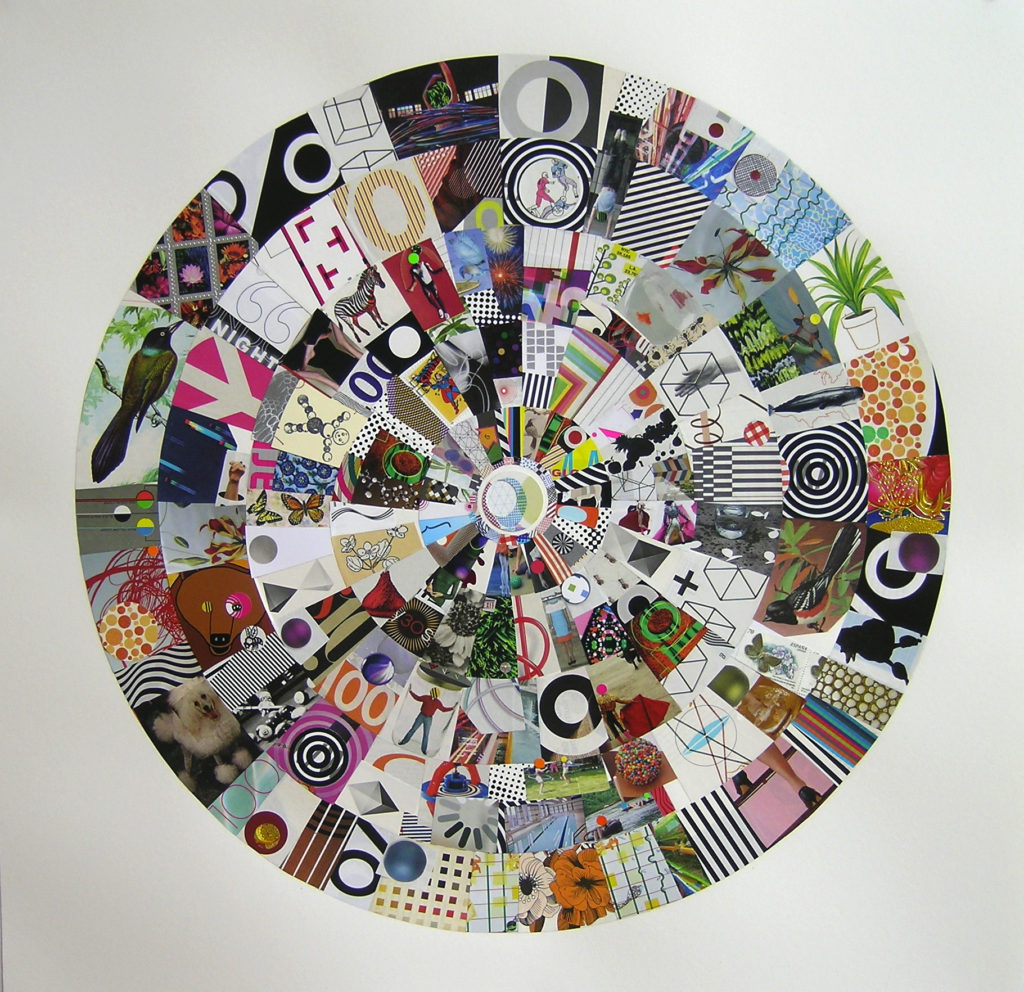
Josette Urso makes paintings, drawings and collages in direct and urgent response to her immediate environment. Large windows in her Brooklyn studio space afford her expansive views of the city, the weather, the light and colors, which all inform and inspire her work. In their variety, materials also nourish her practice. Urso’s approach involves “moment-to-moment” extrapolation where the contrasts and cross-fertilizations are cumulative, non-linear, free flowing and interpretive. For Urso, space is a malleable substance that she delights in manipulating in a kind of gymnasium of mark making and image collision. Working in multiple mediums, her process engages the known, as well as the unknown in unforeseen ways.
Growing up Urso’s parents brought creativity into their everyday lives; she describes her mom as “resourceful and fearless”. Her father, a math professor, played the guitar. Both encouraged Urso’s artmaking, arranging lessons with students at the nearby university where he taught. Spending three semesters in New York during her undergrad years inspired her and made a profound impression. Urso immersed herself in the art, seeing everything she could and becoming familiar with works by a wide range of artists. Women artists that have left a lasting impression on Urso include: Lee Krasner, Florentine Stettheimer, Anne Truitt and the choreographer Pina Bausch.
Urso received her MFA from the University of South Florida in Tampa. Her work has been exhibited extensively, including exhibitions in New York at Markel Fine Arts, Kenise Barnes Fine Art, The Painting Center, The Drawing Center, The New York Public Library, The Bronx Museum of the Arts and in California at the Museum of Los Gatos and Chandler Fine Art. She has received grants and residencies including those from the NEA, Basil H. Alkazzi and the Gottlieb, Pollock-Krasner and Ruth and Harold Chenven Foundations as well as the Camargo Foundation, Ucross and Yaddo.
Day 20: Elena Zolotnisky, http://www.zolotnitsky.com
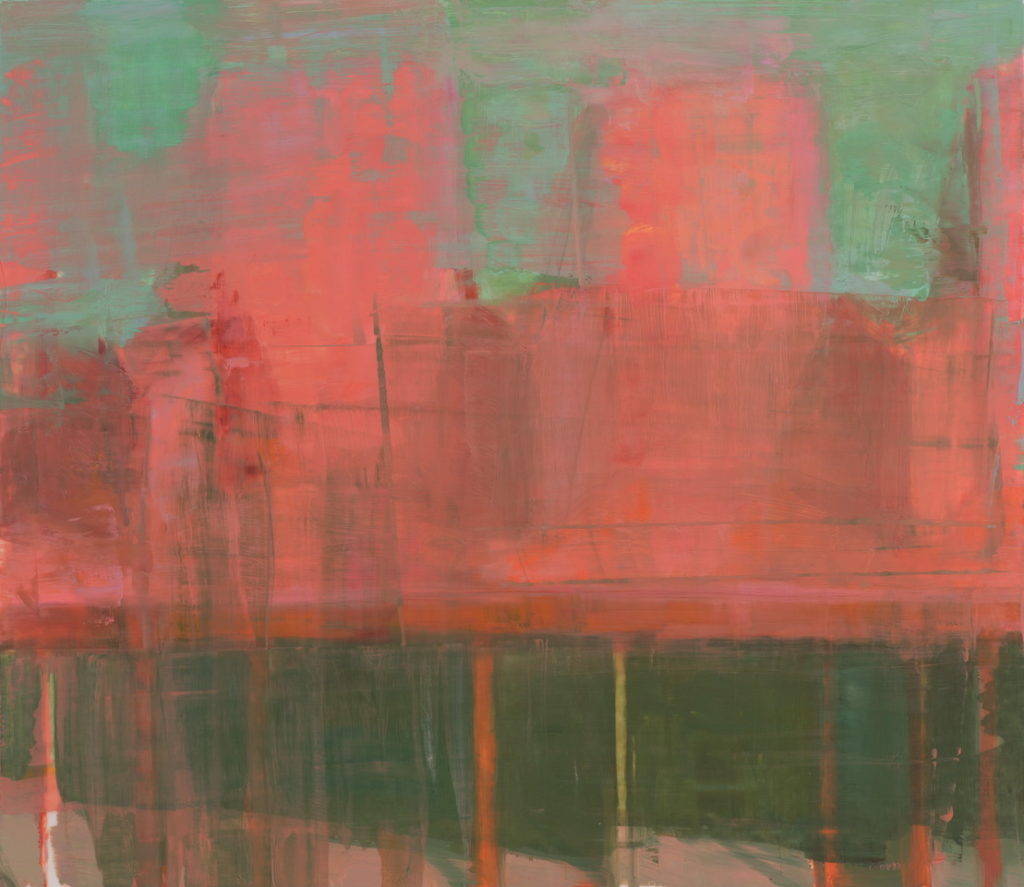
Elena Zolotnisky grew up in Moscow. Her father worked as a freelance illustrator and a set designer at a Moscow Movie Studio. Encouraged to draw and paint, Zolotnisky became serious about art and attended VGIK (All State Institute of Cinematography). Majoring in the Art of Animation, her culminating project at graduation was a ten-minute hand animation movie titled From 9am to 6pm. Zolotnisky was the creative director, and both the director and the screen writer were women. The movie is about one day in the life of a woman architect juggling the demands of her creativity, career and family. It was groundbreaking because they were the first all-women’s creative team and it was one of the first animations made with adults in mind. The movie is still shown in Russia, often around March 8th, International Women’s Day. Zolotnisky notes that the celluloid, the transparent plastic sheets that were used as a surface for painting and drawing animation, are still a part of her practice today. She currently works with oil on a variety of supports but favors mylar/celluloid as it is the hardest to control, super slick surface. She finds these materials very challenging and engaging, keeping her totally focused.
Zolotnisky’s day starts with a 10 mile walk around Lake Merritt in Oakland. She explains “when I do not have that walk my whole day is thrown off. It clears my head, I can daydream about the day ahead and think about my new projects.” Her practice has changed with a deepening of her understanding of her own painting. For many years she found her paintings to be very controlled, perhaps because of the editorial illustration she was working on, or because she was still trying to “find” herself. Now she refers to this earlier body of work as “coloring between the lines”. Gradually after a period of ups and downs, creative blocks, and moving thirty years into her career, she understands her painting. She understands how to make it alive, change and grow.
Inspirations shift, though she does get inspired by faces live or in photos. She admires a strong point of view, craft, a deep understanding of the media, a voice, a vulnerability, a mystery. She states “those revelations make my day. They tweak my creativity in this or that way, very slightly. They stay with me on my early morning walks.” A female role model from history is Hellen Keller and her role models from present days are some of her girlfriends. “They live in different parts of the world. Some of them have been having a very hard life—poor health, insufficient funds, but they keep it together. They persevere. They grow old as I do. They have their problems, but they never give up. They inspire me.”
Day 21: Sawyer Rose, http://www.sawyerrose.com
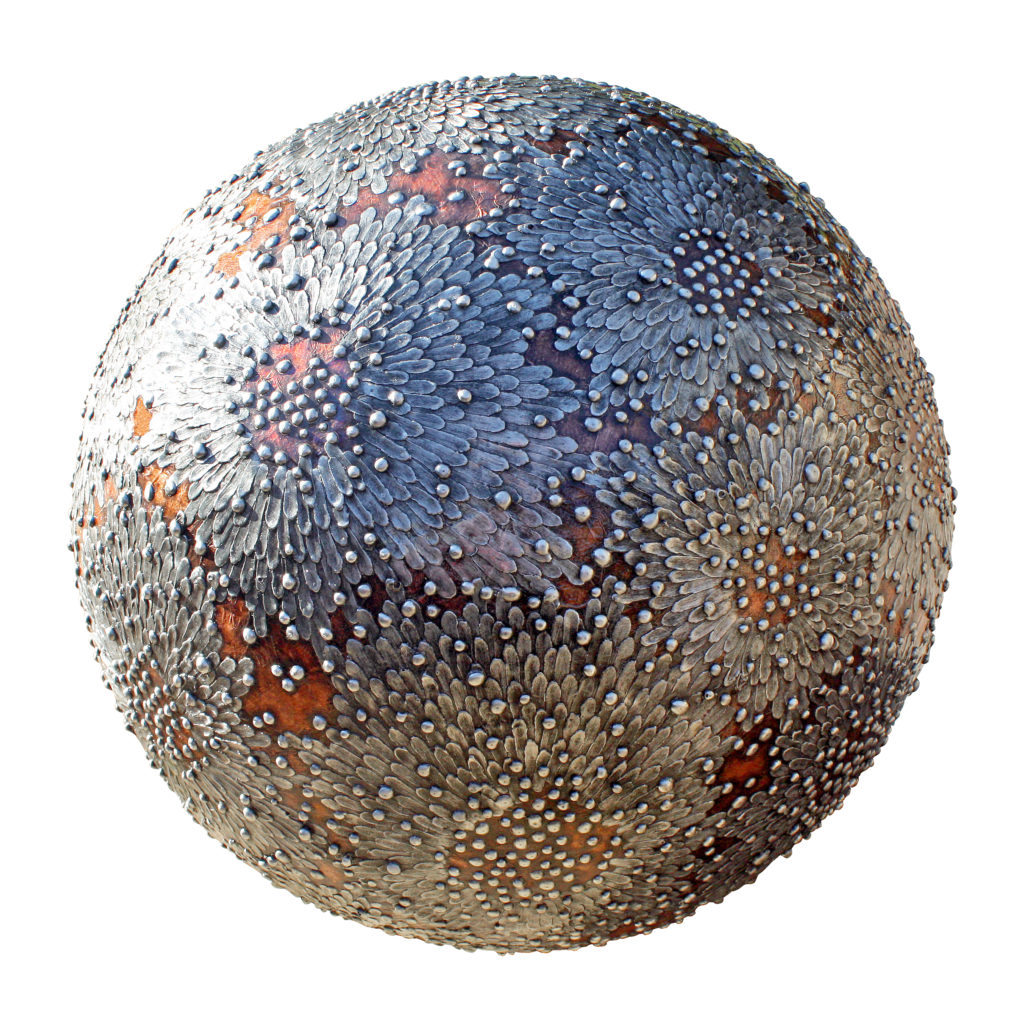
When Sawyer Rose started at Williams College, it took just six weeks for her to decide that she wanted to major in Art. She recalls, “Fortunately, the department required both Art History and studio classes, so I ended up with a well-rounded experience.”
Her senior year painting professor was completely comfortable with her odd studio hours and wild experimentation on canvas. So was her photography tutor at Glasgow School of Art. She learned a lot in both of their classes, but the most valuable takeaway was that it was ok, even encouraged, to let her practice develop outside of the academic box.
Rose began her practice as an oil painter, but now works mostly in metal, wood and fiber. She finds natural, earthy materials to be the easiest to wrap her mind around. “Metal is a finicky, willful material to work with, which I have learned to enjoy. Metal does as it pleases.” She likes to make work that shines a light on social and environmental topics that are important to her. Her metalworks are based on the native flora of California and ask viewers to consider what plants would look like if they could grow armor to protect themselves.
Rose is attracted to art that highlights repetition and pattern while still maintaining an organic sensibility. Near-symmetry and flawed reproduction are mainstays of her own production process. She finds Lee Bontecou’s sculpture work stunning. Bontecou’s steel and canvas wall pieces are particularly inspiring for her, as Rose also works in metal. “It takes my breath away every time—her armatures are the stuff of dreams.”
In another vein of her practice, Sawyer Rose’s work on The Carrying Stones Project takes a deep dive into women’s work inequity. This project looks at women’s paid and unpaid labor, as well as the wage gap, representation of women the workplace, and other ways in which people who identify as female are fighting an uphill battle at work and in their communities. In the next year Rose will be building a new group of installation sculptures for The Carrying Stones Project. She will also publish a book of all the work from the project.
Day 22: Karen Gallager-Iverson, http://www.gallagheriverson.com
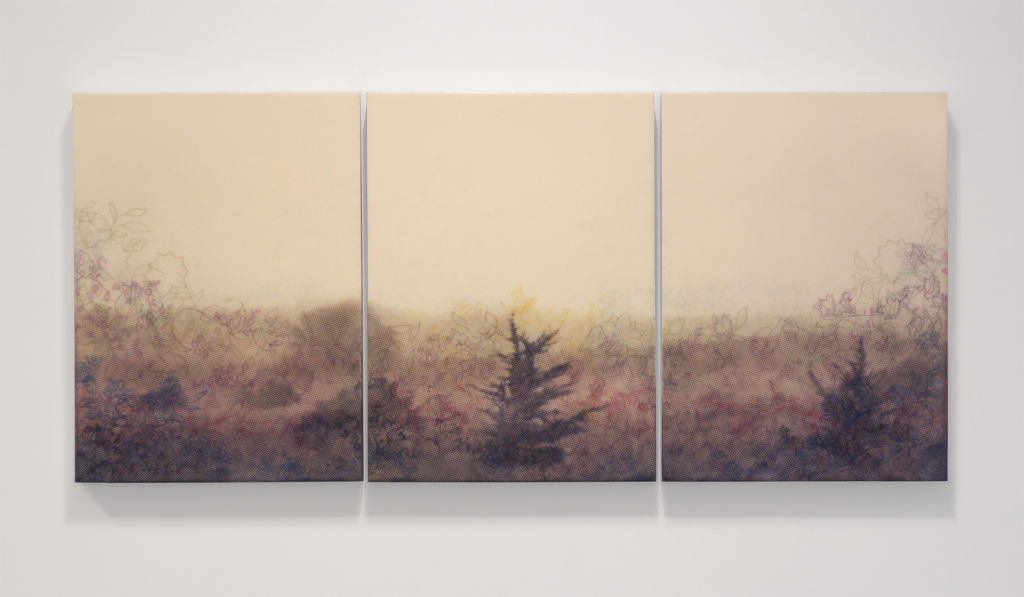
Karen Gallagher Iverson originally went to college with the intent to study Archeology and Anthropology, and minor in Studio Arts at SUNY, Albany. This quickly became a double major and then a life changing experience influenced this decision—her apartment caught fire and burned down. She realized after fleeing the burning building that what she was studying in the ground wasn’t necessarily the truth of life, instead it was a record of what wasn’t important enough to take when braving the flames of change. “You grab what’s alive when you flee.” The truth of this to Gallagher Iverson is that the vibrancy of a culture is what lives on with you. She realized that semester that she wanted to sink into that vision of the world, and visual art served it best. Gallagher Iverson graduated with her degree in Studio Arts and went on to earn her MFA at San Francisco Art Institute.
Once Gallagher Iverson enters the studio below her home, she is “on the clock” and doesn’t take care of family things until she returns with her children after school. Guarding this work time, her daily practice starts with a review of her notebooks and planner to see what tasks need to be done or where she left off the day before. She keeps notes on everything: colors mixed and used, material ratios, exposure times, even when she last installed a new blade in her cutter. She also logs random thoughts and ideas that come up while she is working. Her approach to printmaking is very methodical. She says, “much of what people consider in the moment creative expression happens for me in my mind, in the way I plan things to layer, through the choices I make along the way, and when I’m drawing into my final layers.” Central to her work is integrating some aspect of printmaking. Gallagher Iverson explains “once I realized it could take me where I wanted to go, I didn’t really falter from print; although, as a medium it really can incorporate a whole host of other mediums.” A common theme in most of her current work can be “reduced to catching, or translating, light and dimension though pattern.”
It is things like sudden shifts in light that truly inspire Gallagher Iverson. Along with these natural phenomena, she admires the work of Louise Bourgeois and Agnes Martin. Everything Gallagher Iverson read about Bourgeois pointed to a person of skill, tenacity and prolific activity. She finds Bourgeois’ drawings and drypoint etchings most compelling. With Agnes Martin, Gallagher Iverson says that it is “just honest, beautiful artwork. And work that was able to rise with success in a very male art world.”
Day 23: Brigitte McReynolds, http://www.brigittemcreynolds.com

Brigitte McReynolds’ practice is a continuous investigation of abstraction and exploration of the human form. It is her visual diary, a “paper trail” of a process that is both spontaneous and deliberate. Working in layers of paint, she merges luminous color and palpable texture. For McReynolds, painting is a dynamic, intuitive process. A drip or smear reveals part of that process.
McReynolds works in series that start as a concept in her mind, or as a vision of a finished work. It can also begin as an emotion or process of the heart. When she develops a theme, she explores it in multiple materials: oil, acrylic, and encaustic, working figuratively and abstractly until the idea exhausts itself, or leads to another theme. McReynolds applies what she learns from shape, form and line in her abstract paintings to find the simplicity that is needed for abstracting a figure. Similarly, her abstract work profits from her figurative experience.
Her works often have a recurrent pattern or an illusion of repetition. However, not one shape is the same as the other. Similar to life, where we have days, hours and minutes that create a pattern, yet not a single moment resembles the next. McReynolds explains “Although I enjoy working with the “shapelessness” of stripes I also love to work on abstract paintings that maintain shapes and forms. A shape in a painting is like a figure in a landscape. For me the abstract shapes are alive. They have a heart, an area with vibrant color; intense brush strokes, the limbs.”
When contemplating inspiration, McReynolds finds the mystic works of Hilma af Klint breathtaking and has never forgotten her visit to the Italian Tarot Garden designed by Niki de Saint Phalle. Inspiration also comes to her from women speaking out for the #MeToo movement, and from the work of public figures like Supreme Court Justice Ruth Bader Ginsburg and Senator Nancy Pelosi. McReynolds is most inspired by her mother, whom she describes as a creative, kind, humble and generous woman who was able to raise nine children while working hard running a restaurant and hotel.
Day 24: Sara V Cole, http://www.saravcoleart.com
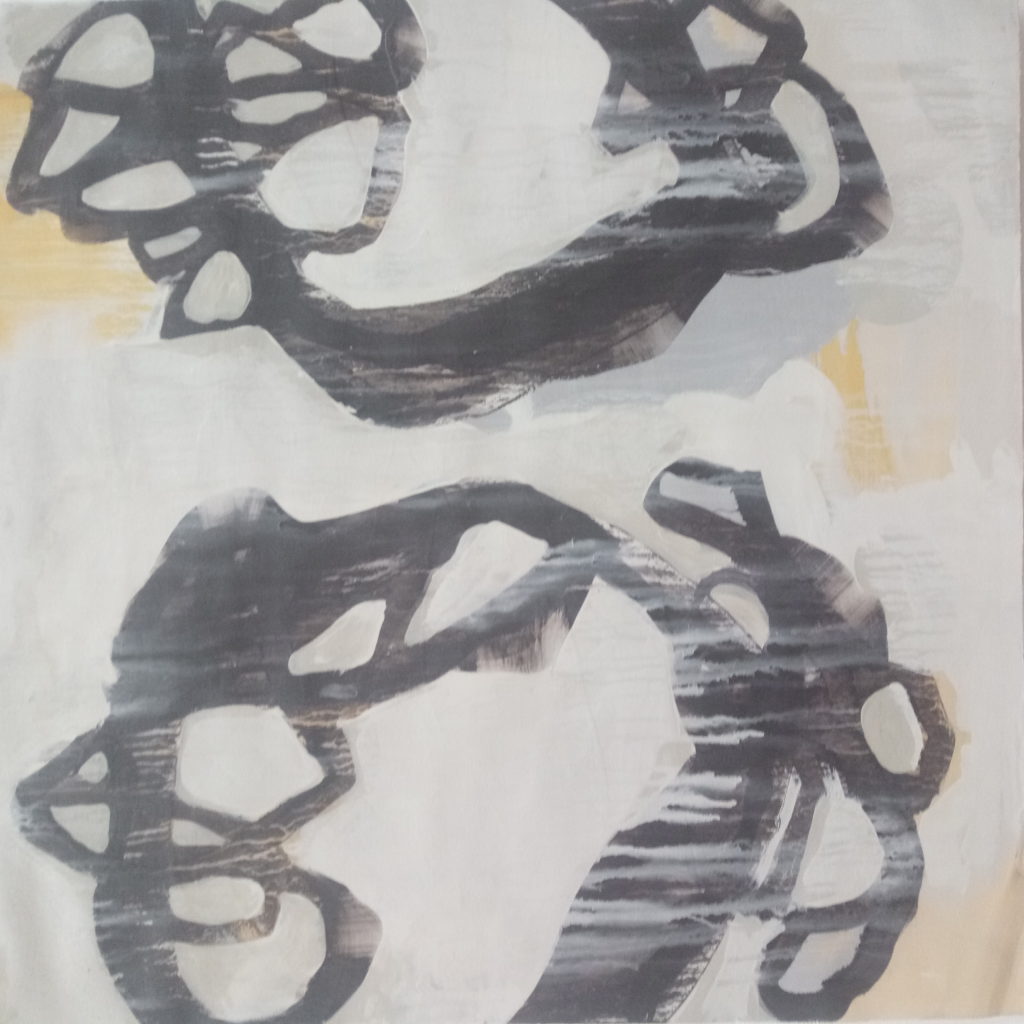
Sara V Cole is a nationally represented, internationally exhibited author, teacher and fine art painter with a full-time art making studio practice. Cole earned her BFA in ceramic sculpture and installation/performance art with a minor in art history. She then completed her MFA in painting and drawing and went on to study graduate level Non-Western Contemporary Art History, all at San José State University.
When considering women in art and history that have made an impact on her life, Cole listed dozens of women, from artists to politicians. In the category of women artists, she says, “I could name fifty I love, but here are ten that I am obsessed with: Adrienne Piper, Alice Neel, Julie Mehretu, Shahzia Sikander, Käthe Kollwitz, Hung Liu, Artemesia, Ann Hamilton, Marlene Dumas and of course who doesn’t love a little Frida!” In addition to this top ten, Cole recalled seeing the SFMOMA Eva Hesse exhibition in 2002. She says she still responds to the memories of this exhibition and that fragments of those works continue to resonate in her own work today.
Thinking back to her childhood, she described “growing up with a radical hippie 1960s mom and cannot remember a day that I didn’t know about Gloria Steinem, Dorothy Pitman-Hughes and Ms. Magazine.” Her favorite female authors include Maya Angelou, Joy Harjo, Mary Oliver, bell hooks, Audre Lorde and Sylvia Plath. Other “badass women” also inform and inspire her life, such as: Ruth Bader Ginsburg, Simone de Beauvoir, Betty Friedan, Angela Davis, Shirley Chisholm, Elizabeth Warren, Kamala Harris and Michelle Obama.
Cole has placed work in the permanent collections of The Triton Museum of Art, Hilton Hotels, the Microsoft Collection, Stanford University, the MGM Grand in Las Vegas, the Ritz Carlton in Laguna Niguel, the Grand Hyatt in Atlanta, Iberia Bank in Louisiana, and De Anza College in Cupertino. Her work can be found in the private collections of many patrons including that of Actress Sela Ward and the New York based National Art Buyer for One King’s Lane. She has an extensive exhibition history including New York City’s Asian Cultural Center Gallery and group exhibitions from Seattle, Washington to Metz, France.
Day 25: Michelle Gregor, http://www.gregorsculptor.com
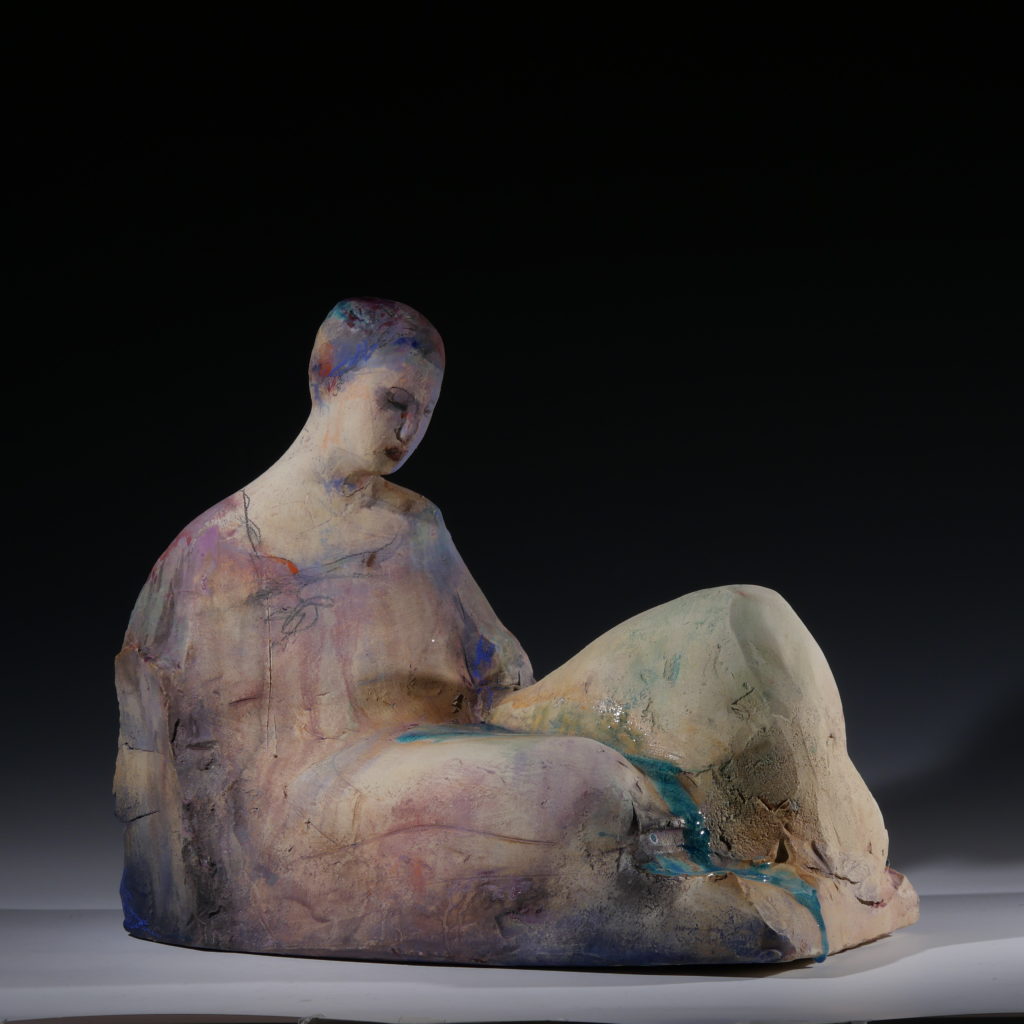
Creative since she was a child, Michelle Gregor always had a vivid imagination and loved to draw and make things with her hands. Her mom encouraged her to study what she loved, so Gregor took art classes. She ultimately found her creative voice in the clay studio during her first year of college. Gregor says, “the communal aspect of the art studio felt like my spiritual home. I’ve always been drawn to creative people, they are the source of my greatest wealth, my artist family.” She had the opportunity to study with and be deeply influenced by teachers who were practicing artists: Stephen DeStaebler at SFSU, David Kuraoka at SFSU, Sheldon Kaganoff at UCSB and Sandra Johnstone at UCSC.
Today, as a professor and practicing artist herself, she pursues themes that are both figurative and abstract. The figure provides a vehicle to explore form, shape, texture, color and space. Gregor feels she “will never tire of it!” Abstraction has limitless potential to describe emotional and spiritual states. “Together the two themes encompass our human existence. My work explores what it is to be inside our human containers.”
For Gregor, “inspiration comes in so many forms; a poem by Mary Oliver, a canvas by Joan Mitchell, a story by Haruki Murakami… I am deeply inspired by artists of all kinds. I never lack inspiration. It surrounds me both in culture and in nature.” When she was a young girl, she spent a lot of time in her small-town library. She recalls being particularly interested in the art section and was perplexed why there were so few books on women artists. She remembers counting only three books with women’s names on the spine: O’Keeffe, Imogene Cunningham and one other. From that day on, she has relentlessly pursued finding everything she can about women artists and their creative processes. Gregor still recalls the thrill of discovering Artemisia Gentileschi. Her female role models are many and have shifted places as the years progress. Her earliest heroine was Georgia O’Keeffe followed by Anaïs Nin and Colette. Now she looks to Abstract Expressionist painters like Joan Mitchell and Lee Krasner for inspiration. Artists like Kiki Smith, Phyllida Barlow and Kara Walker also are part of her pantheon.
Day 26: Ivy Jacobsen, http://www.ivyjacobsen.com
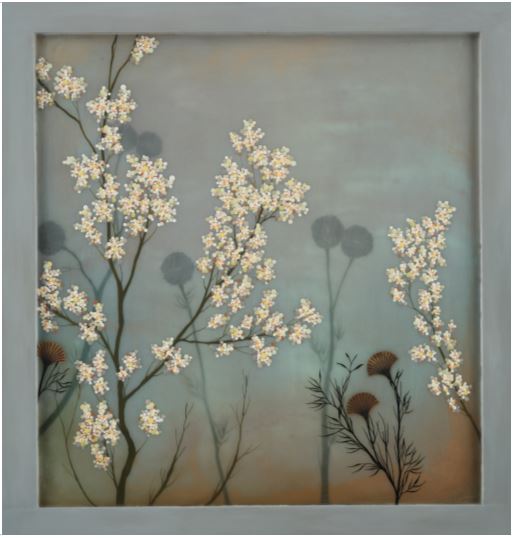
Nature inspires Ivy Jacobsen. She spent her early childhood living on a farm amongst the fruit orchards of Kingsburg, in the Central Valley of California. During high school Jacobsen moved to Pacific Grove, where she became aquatinted with the beauty of the natural landscapes and seascapes of the coast. She is inspired by nature in all of her art making. Since she paints from imagination, Jacobsen focuses on memories of nature and different plants. Her stylized work does not rely on accuracies, but rather on the essence of the species.
In 1997 Jacobsen took her first painting class and instantly became hooked; it solidified by declaring her art major in college. Two years later she earned her BA in painting and printmaking from SFSU. She continued developing skills by taking painting classes at SFAI and printmaking classes through City College of San Francisco at Fort Mason Center. Influential teachers include artist Paul Pratchenko, her painting instructor at SFSU, and the late painter Glen Hirsch, a painting instructor at SFAI.
Jacobsen’s practice has become more focused in recent years. She now has a family and has less time to devote to the studio. Nevertheless, when she is in the studio, she feels more productive and diligent than before children. Every hour counts, so she uses her time wisely. In her current work, she uses oil and acrylic paint layered with 2-part epoxy resin to give the illusion of atmosphere and depth. Recently she has been incorporating collage into her paintings.
Besides nature, inspiration comes from Japanese art, Chinese art and botanical illustrations. She is particularly interested in woman artists who balance motherhood with being a full-time artist, as it is encouraging to learn about artists who balance other demands. She is also moved by the work of Yvette Molina and the innovative paintings and flowers of Georgia O’Keeffe.
Day 27: Carole Rafferty, http://www.carolerafferty.com
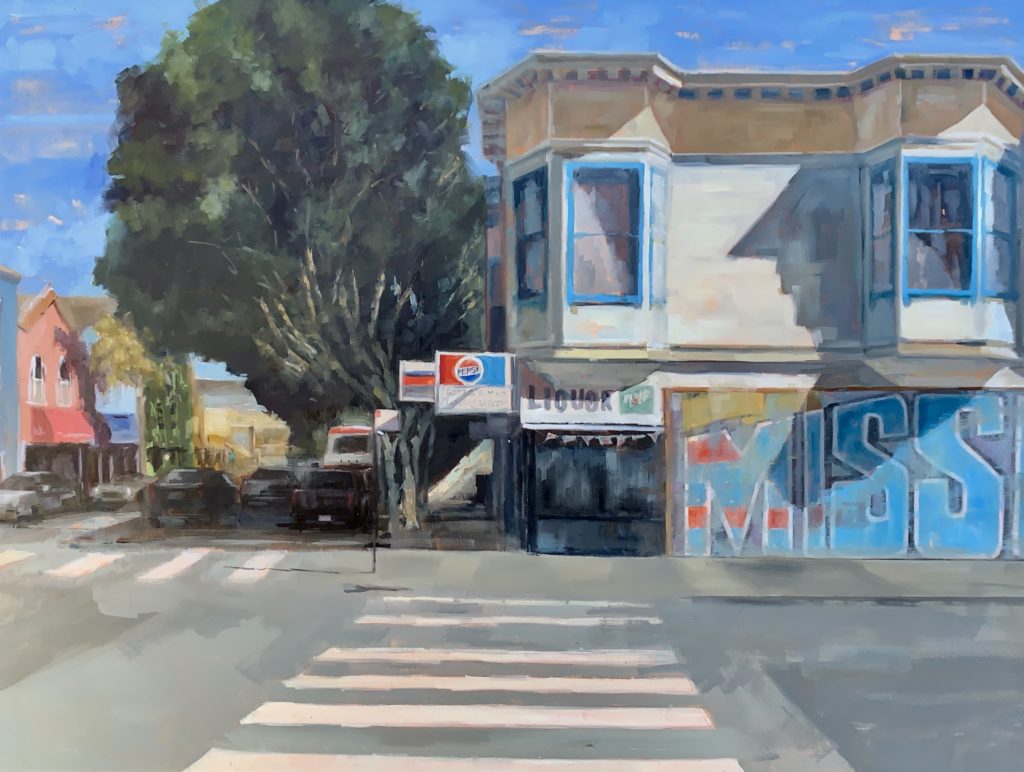
Carole Rafferty has sat behind the easel, and in front of it. Her grandmother was an accomplished portrait painter and as child she spent many excruciating hours posing for her. Rafferty recalls that “I had no appreciation whatsoever for what she was doing, and I dreaded her visits because it meant I’d have to sit still for hours on end without even being able to even talk.” Despite this, Rafferty developed a passion for art, painting in high school and taking life drawing classes at night. During these formative years the women in her life planted the seeds for her growth as an artist. Rafferty says, “all my art teachers at that point, from my grandmother to the teachers in high school to my aunties in India who ran fabric dying and printing companies, were all women. Looking back now —even though I didn’t appreciate ANY of them at the time—they all had an enormous influence on how I was to turn out.”
Rafferty moved to London for college and began a four-year degree in Asian languages and history at the School of Oriental and African Studies, essentially learning a history of art. She also learned Sanskrit for translating inscriptions and the differences in symbolism and style between the various Indian dynasties. When she graduated, she moved to California to begin a professional master’s program at UC Berkeley in Asian Studies and journalism. From there she became a reporter, working for the New York Times in San Francisco, and eventually the Mercury News in San Jose. Unfortunately, after several decades of cradling the phone between her head and shoulder and typing notes into the computer, the discs in her cervical spine gave out.
During her transition from work at the newspaper she decided to take a beginning drawing class at Foothill Community College. Being back in art class was completely life changing. Rafferty threw herself into art and pursued it all: oils, watercolors, sculpture, plein air, portraiture, landscape painting, encaustics, and more. She says, “you name it, I took it!” After several years of study with number of local teachers, she eventually came to the realization that you can’t spend all your time in classes, you’ve got to just do it!
Today her art practice follows a regular routine. Starting most days with a brisk walk around the Stanford Dish, she returns home to go straight into her studio. “I usually start painting around 9am and on a good day I’ll continue until about 4:30. Other days I spend wandering around the city with my iPhone, sketch book and watercolors, looking for new ideas and new scenes. Sometimes I go to the beach and paint a seascape.”
Day 28: Shannon Amidon, www.shannonamidon.com
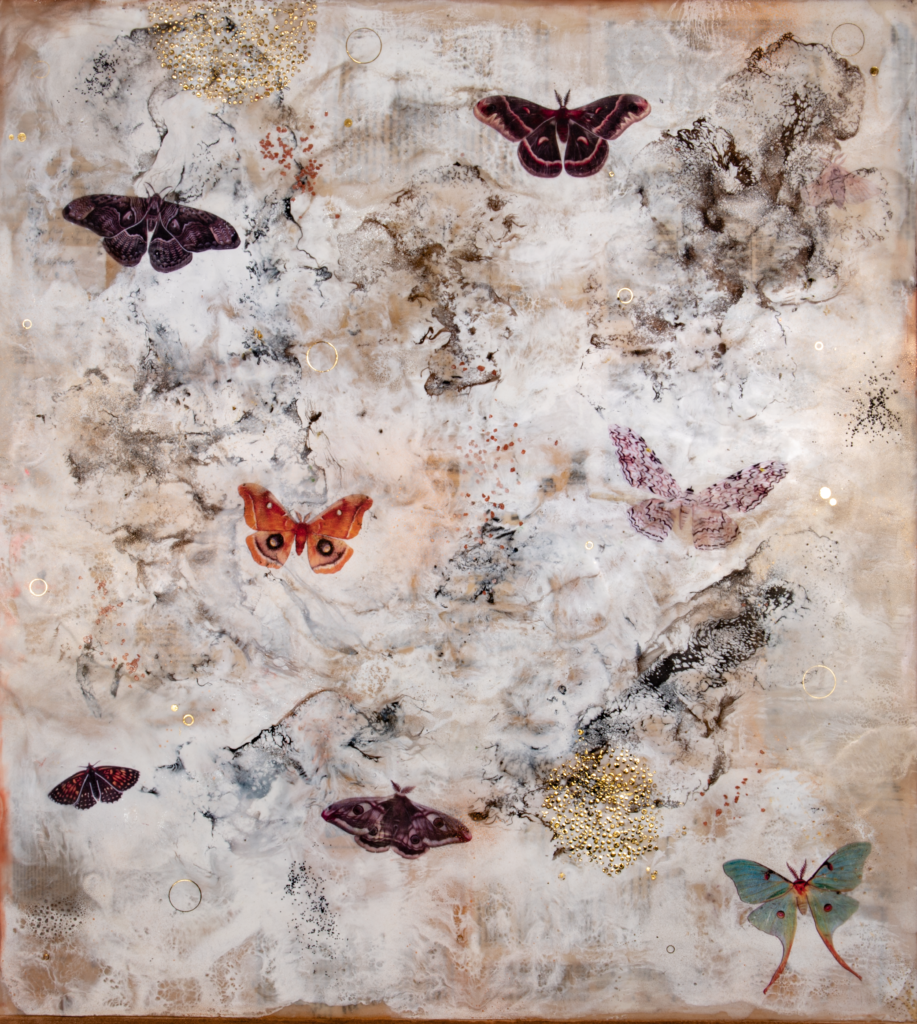
Shannon Amidon never went to galleries or museums growing up and didn’t really have an idea of what fine art was as a child. Nonetheless she always knew she loved creating and making things. In college she discovered photography and fell in love with the medium and the dark room. Having no formal training or skills in drawing or painting, photography was a natural and exciting way for her to express herself. She took photography courses, including an alternative process photography class with Brian Taylor (SJSU) that became a profound influence. Professor Taylor was “a generous and encouraging teacher and an incredible artist.” His work opened a new world for Amidon through a mixed media approach to photography. For Amidon this was a method to make the hand of the artist evident in her photography. She painted on emulsions, printed on fabric, wood and other substrates, and experimented with cameraless techniques. Over the years, Amidon’s practice has changed and evolved significantly, but she says her “first love and roots will always be in photography.”
Broadly Amidon’s artwork explores themes of nature, science and our environmental impact. The cycles of life, death and impermanence play a primary role in her work. Amidon feels that art should be an investigation similar to science, by asking questions, researching and seeking to see things in new or different ways. Curiosity is fundamental in her practice. As the cycles of life, curiosity, discovery and science inspire Amidon, so does the act of art making itself. Among women artists, she is drawn to the work of Eve Hesse, admiring her dedication to material and process. She is also encouraged by the work of Neri Oxman and Zaria Forman and sees them “really pushing the boundaries and shining a creative light on climate change and the environment.”
Several significant life experiences, both personal and professional, have impacted Amidon’s work. In the last decade she lost seven loved ones within seven years, including her parents and grandparents. During this time, she also became a new mother to an amazing daughter. This duality of life and death, as well as becoming a mother as she lost her own, significantly changed her practice, color palette and the meaning of her work. Amidon explains that her “art went through a complete sea change. Most surprising is that it didn’t make it darker or melancholy, in fact observing and experiencing these cycles of life firsthand gave my work more hope, lightness and depth.”
Day 29: Kim Frohsin, http://www.kimfrohsin.com
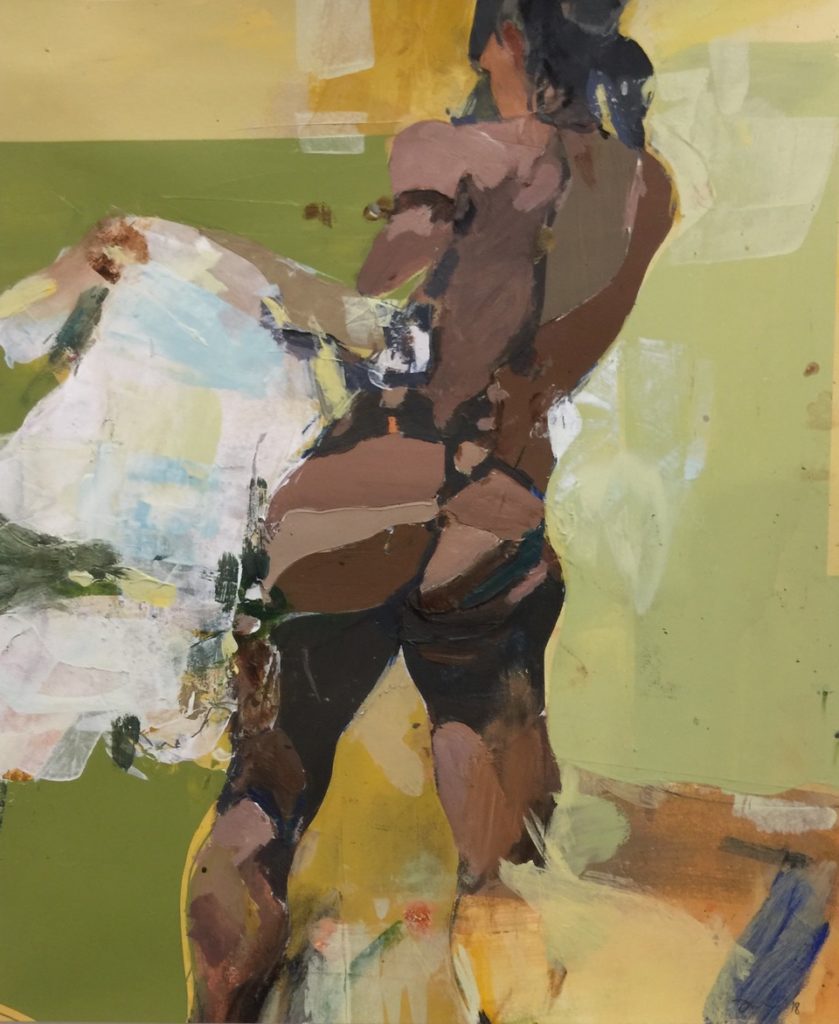
A prolific artist, Kim Frohsin works in painting, drawing, printmaking, and mixed media. Her subjects include the female figure, landscapes and cityscapes, as well as objects, themes and series that attract her attention, and which are most often autobiographical in nature. She began exhibiting in the San Francisco Bay Area in the early 1990s, and in 1993 was included with Nathan Olivera, Manuel Neri and Stephen De Staebler in the exhibit Four Figures from the Bay. With Wayne Thiebaud as the juror, Frohsin won the California Society of Printmakers’ Award in 1996, and the following year exhibited at the de Young Museum in San Francisco in Bay Area Art: The Morgan Flagg Collection.
Frohsin received her BFA from The Academy of Art College in San Francisco. For more than thirty years she has exhibited in many solo and group exhibitions throughout the United States. Her work can be found in both private and public collections including The Coca-Cola Corporation, Heritage Communications, Atlanta, GA; The Gap Inc., San Francisco, CA; The Crocker Art Museum, Sacramento, CA; and The San Jose Museum of Art, San Jose, CA. Frohsin is represented by Andra Norris Gallery, Burlingame; b. sakata garo, Sacramento; Paul Thiebaud Gallery, San Francisco and Thomas Reynolds Gallery, San Francisco.
Day 30: Chris Hayman, http://www.chrishaymanart.com
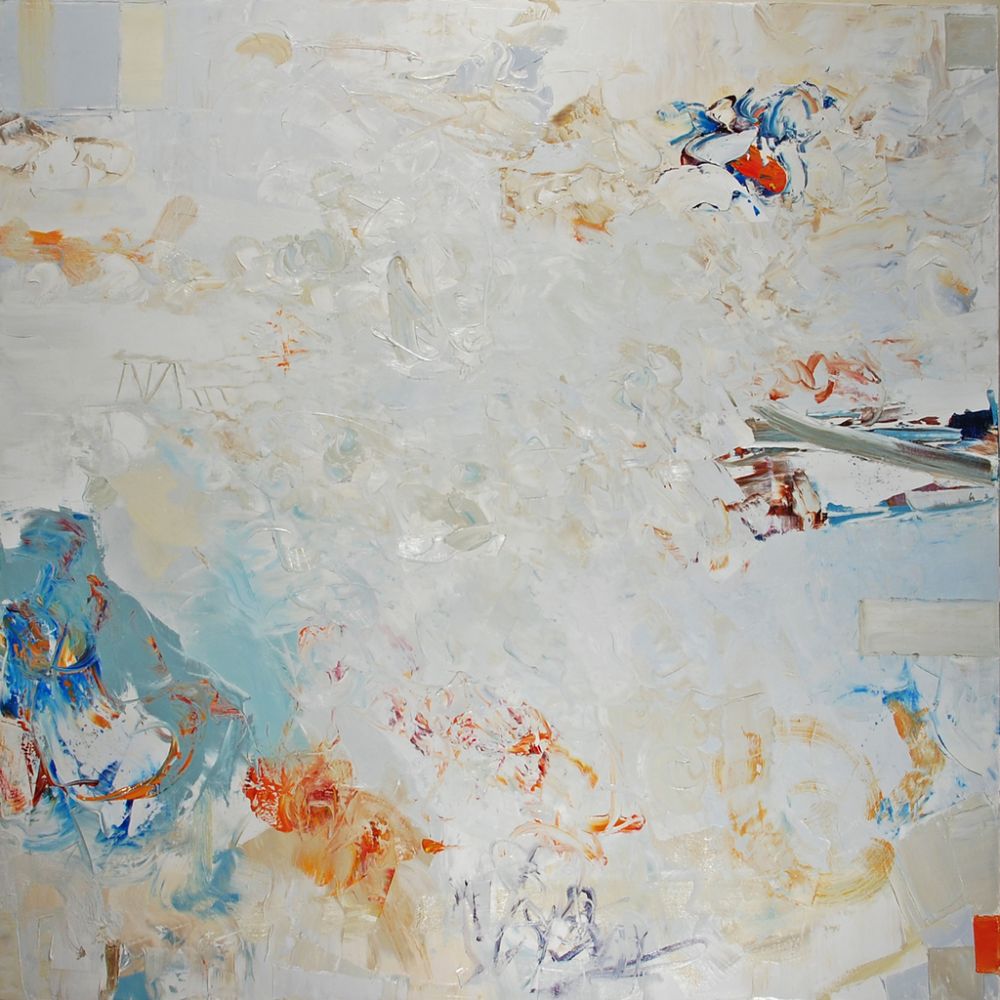
Trained early on as a classical pianist, Christine Hayman is greatly inspired and influenced by music in her life. She was also actively involved in theater and dance at the Conservatory of Music in Cincinnati and Baltimore. These creative talents eventually led to her primary focus as a visual artist.
In her paintings, Hayman concerns herself with space. She is interested in how forms are energized by the space around them, especially when incorporated into paintings with vivid contrasting color and thick painterly textures. Along with music, she is also inspired by the natural world, and relies on a practice of constant study and exploration of the rural foothills and open lands near her home and studio.
Hayman received her BA in Art History at the University of Maryland and a second degree in Art at the University of Reno, Nevada where she began her investigation into painting. She currently resides in Northern California on a farm with livestock, orchards, gardens and beautiful surroundings.
Chris Hayman is represented by Whitney Modern Gallery, Los Gatos; Thomas Deans Fine Art, Atlanta; Desta Gallery, San Anselmo, CA; Judy Ferrara Gallery, Three Oaks, MI; Gallery North, Carmel, CA; Jules Place, Boston; Merritt Gallery & Renaissance Fine Arts, Baltimore and Chevy Chase, MD; Haverford, PA; Kelsey Michaels Fine Art, Laguna Beach, CA; Morrison Gallery, Kent, CT; Julie Nester Gallery, Park City, UT; Octavia Art Gallery, Houston and New Orleans.
Day 31: Kelsey Irvin, http://www.kelseyirvin.com
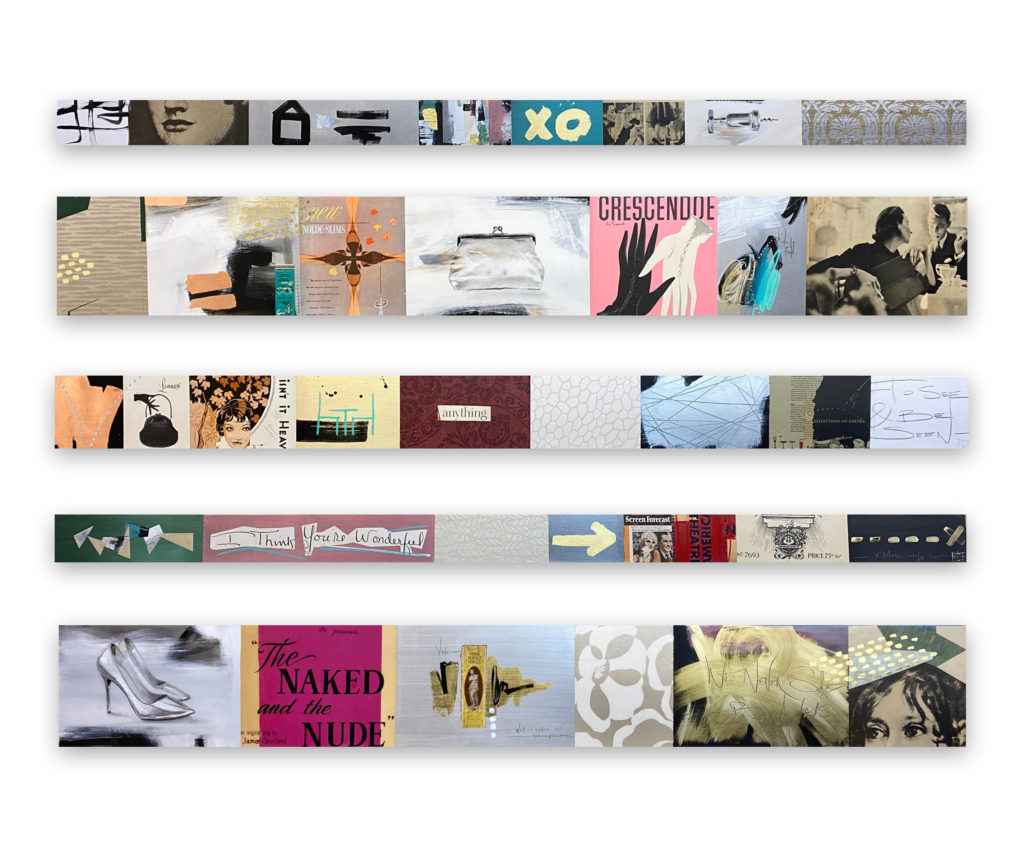
acrylic, and resin on panel, 60 x 72 inches
Contemporary collage artist Kelsey Irvin submitted cartoons to magazines as a child thinking she could be a freelance illustrator in elementary school and middle school. She says she “received very nice rejection letters” but knew she would always love and create art.
Irvin still creates art and she did become a professional artist, though her routines and work patterns have changed a lot over the years. She recalls, “before kids I could easily work 13 hour days and paint until my eyes went blurry.” After the birth of her third child and accepting representation into her seventh gallery, she started a weekly practice of setting specific realistic goals, but also goals that push her a bit.
Appearing like paintings at first view, Irvin’s collages are a treasure hunt of materials upon further investigation. In her process she uses everything and anything: vintage ephemera, fabric from the 1800s, leather, McCall’s dress patterns, Hollywood movie magazines from the ’50s, New York Times fashion ads from the ‘20s, matchbox covers, hand-painted signage, oil, acrylic, graphite, and sometimes resin. The ensuing works conjure memory and nostalgia. There is crossover between past, present, and future, with unifying themes of independence, adventure, the strength of women, and the innocent imagination of childhood.
Irvin is inspired and challenged by the idea of creating something unique that draws people in, brings people back in time, or propels them forward. She finds these qualities in many artists past and present. A woman artist that exemplifies this for Irvin is Helen Frankenthaler, admired for her uninhibited boldness. She thinks of Frankenthaler’s masterpiece Mountains and Sea because of what it represents, both to Irvin and for female artists, she says: “Frankenthaler was inspired, set a new path, stood out among men, and the work is breathtaking.”
Likewise, Kelsey Irvin finds role models in everyday life. “People that are unwavering in their particular passion, highly capable by choice, “doers” because they can’t imagine letting life go by without trying. People who are kind, thoughtful and selfless, but also driven with self-discipline. Women who aren’t afraid to pursue their dream career and motherhood at the same time.” Irvin explains that these aren’t always famous individuals, these are people she meets along the way through life, and people like her mother and grandmother.